Introduction
Sixteenth-century European costume manuscripts and books are rich visual testaments to the culture of the early modern period. These works featured illustrated male and female figures wearing dress representative of civic, regional, or national identities, and sought to comprehend an ever-expanding sense of the world and its people. As the genre was taken up in print in the second half of the century, costume books developed into comprehensive, encyclopedic references of global fashions, such as Cesare Vecellio’s well-known Degli habiti antichi et moderni di diverse parti del mondo (The clothing, ancient and modern, of various parts of the world, 1590). A subject that has attracted interest from historians, art historians, and scholars of comparative literature in recent years, the printed costume book emerged out of personal, eclectic projects in the first half of the century that memorialized individual adventures, encounters, and aspirations.Footnote 1 The best known of these is Christoph Weiditz’s (ca. 1500–59) Trachtenbuch (Costume book), an album that the skilled portrait medalist compiled from sketches gathered between 1529 and 1532 when he traveled from Augsburg to the Spanish imperial court.Footnote 2 Containing pictures largely situated in Iberia but recording human subjects from Italy, France, the Netherlands, Germany, and the New World, it constitutes a notable example of keen ethnographic observation. By illustrating the regional differences of Basque headdresses and the linens of laborers in the fields of Castile (fig. 1), Weiditz’s Trachtenbuch vividly depicts the close relationship between customs, costumes, and cultures, largely witnessed firsthand and portrayed with great dignity.Footnote 3
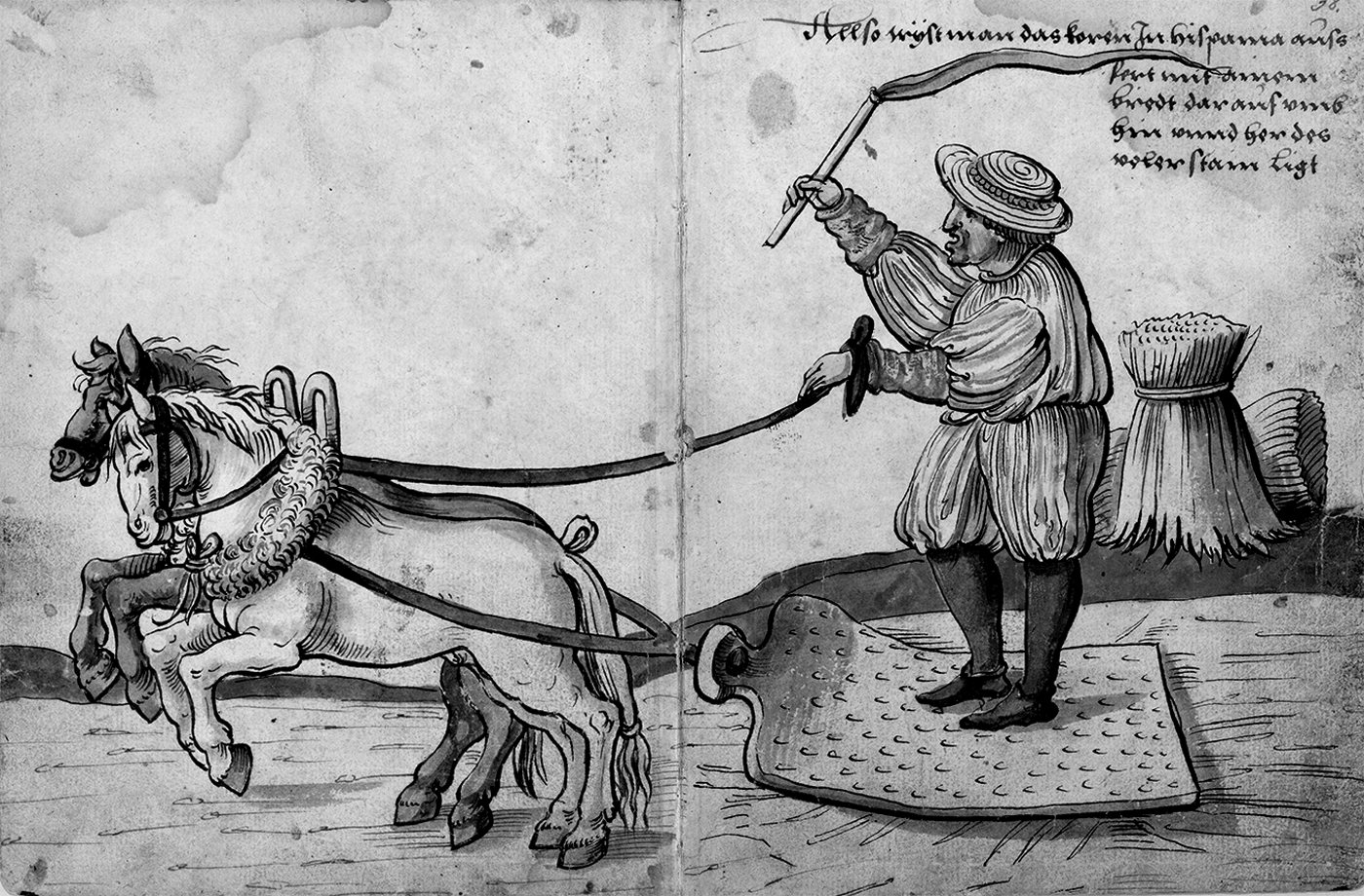
Figure 1. Christoph Weiditz. Threshing corn in Spain, from the Trachtenbuch. Germanisches Nationalmuseum, Nuremberg, Hs. 22474, fols. 37v–38r. © Germanisches Nationalmuseum. Photo: Monika Runge.
This article introduces two comparable manuscripts that are connected to Weiditz’s influence and should be seen as important antecedents to the printed costume book. Christoph von Sternsee’s costume album (ca. 1548–49) and its contemporaneous copy document the cultural landscape of sixteenth-century Europe with remarkable liveliness and an interest in veracity. Commissioned by Sternsee (d. 1560), the captain of Charles V’s German imperial guard, the album’s artistic authorship has remained anonymous. I argue that a series of visual clues and biographical evidence point to the involvement of Dutch artist Jan Cornelisz Vermeyen (ca. 1500–59) as a source for the project’s visual content. The creation of Sternsee’s album coincided with the intensification of Habsburg power under Emperor Charles V (1500–58), whose empire embraced an extraordinary diversity of human subjects. As members of Habsburg networks, Sternsee and Vermeyen spent prolonged periods in the imperial entourage. Mapping out the ideological foundations of the album and rooting it within Sternsee’s and Vermeyen’s personal experiences of travel, war, and empire, the present article argues that imperial Habsburg networks fostered relationships and cross-cultural encounters that helped to inspire costume alba as one of the period’s most novel cultural productions. While existing studies have shown that printed costume books after the reign of Charles V often harbored nationalist, moral agendas, this article draws attention to the contrasting incentive of transnational exchange that prompted Sternsee’s costume album, repositioning the narrative of costume books’ emergence and purpose. By examining the progress of a Habsburg military official through the lens of his personal album, I demonstrate, moreover, the importance of visual culture and biographical microhistory for understanding the interconnectedness of Charles V’s empire.
Christoph Von Sternsee and his Costume Album
In 1548 the middle-aged Sternsee found himself placed at the emperor’s court in Brussels, a city filled with court-sponsored artists and their workshops. He pursued a commission for a richly illustrated album that would commemorate the wealth of people, places, and wildlife he had encountered in a glorious career owed to his patron Charles V. A composite project, the album compiles knowledge of diverse dress practices while also devoting folios to historical events, imperial acts, heraldry, flora, and fauna. Preserved in the Museo Stibbert in Florence, Sternsee’s album retains 179 surviving vellum folios rebound into a larger volume of costume drawings by the English collector Richard Bull (1725–1805).Footnote 4 A reduced and broadly contemporaneous copy of the Stibbert MS is held by the Biblioteca Nacional de España in Madrid.Footnote 5 The copy does not contain the original’s folios of heraldry or its illustrations of animals and ships.Footnote 6 Although differences are found in the deployment of color and ornamentation, the two manuscripts’ corresponding illustrations closely match in style and line.Footnote 7
Sternsee’s album begins with pages of the heraldic arms of kingdoms and duchies under Habsburg territorial rule.Footnote 8 Emblazoned on a full-page is the double-headed imperial eagle, succeeded by two portrait roundels of Charles V and his consort, Isabella of Portugal (1503–39). These pages introduce the emperor’s centrality to the project, the visual program of which covers territories in his possession as well as those of long-standing rivals. Representing these territories are costume figures from Spain, Portugal, Tunis, the New World, France, Flanders, the Netherlands, Friesland, England, Ireland, Germany, Hungary, Croatia, Greece, Turkey, and Italy.Footnote 9 The costume figures are frequently arranged into small groups of people. Often facing each other and appearing in conversation, the artist is able to show multiple perspectives of their clothing. Interspersed between series of costume figures and structuring their territorial subjecthood are the coats of arms belonging to these territories, along with those of their various sovereigns, including the kings of France and England; the dukes of Milan, Genoa, and Orleans; Pope Paul III; and Ferdinand I, king of Hungary and Bohemia. The album features exotic animals and ships associated with the emperor’s Tunis campaign of 1535, as well as a couple of full-page scenes illustrating Charles V’s ceremonial titles and the Ottoman emperor Suleiman I (1494–1566) sitting in state. The final pages attribute the commission to Christoph von Sternsee, whose name and coat of arms, as well as those of his wife, parents, and grandparents on both sides, are painted over a series of four folios (fig. 2).Footnote 10
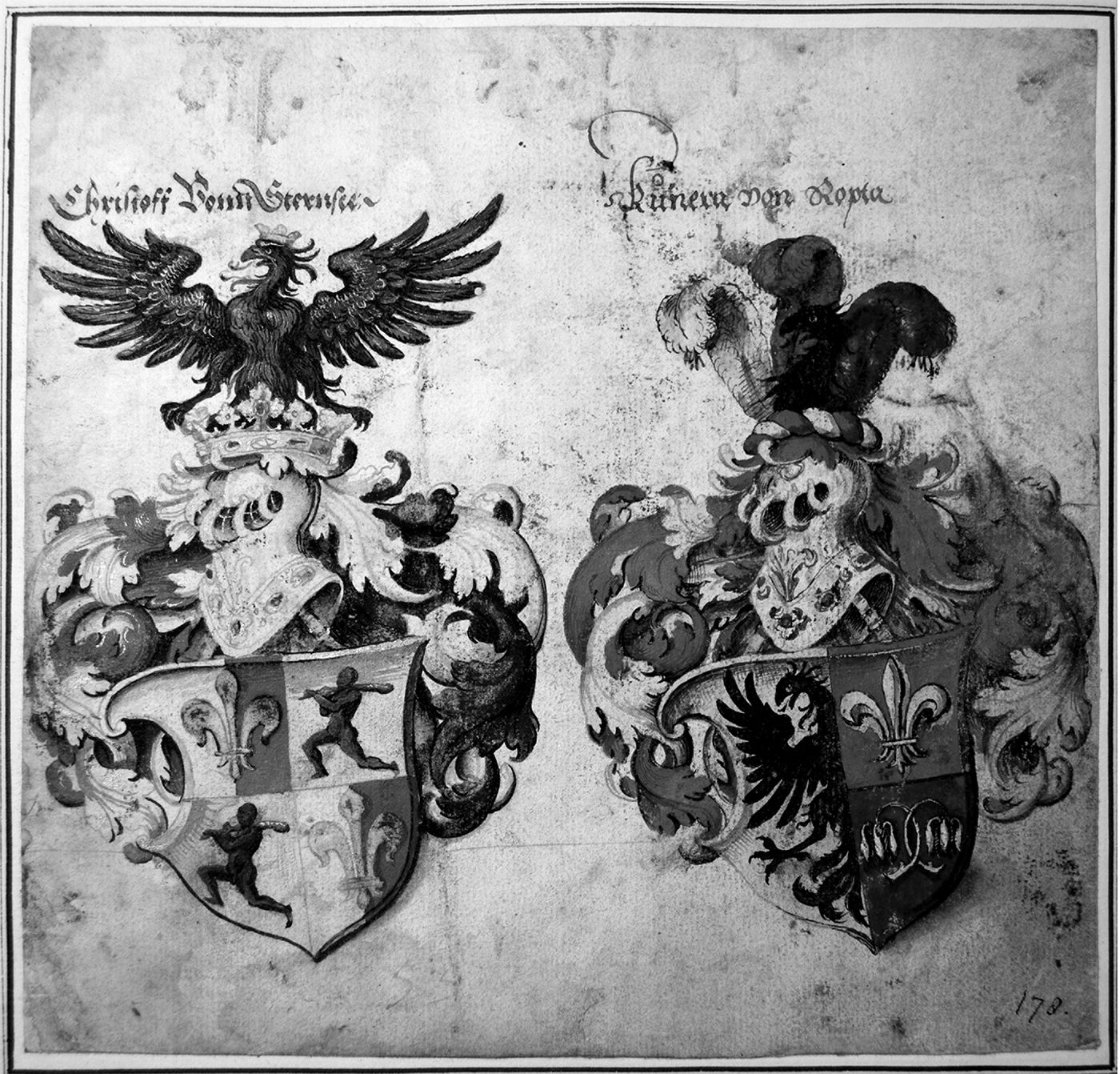
Figure 2. Coat of arms of Christoph von Sternsee and Kunera van Ropta. Reference BuchananMuseo Stibbert, Florence, MS Cat. 2025, fol. 178. Photo: © Museo Stibbert.
At a glance, Sternsee’s album embodies the contemporary ethnographic curiosity for foreign cultures that existed in tension with expansionist politics in an age of global conquest and European power struggles. Sternsee’s particular fascination with dress habits was surely sparked by his impressions of the curious, vacillating clothing styles and manners he observed as he navigated Europe’s regions in the service of the Habsburgs. His album depicts women with cropped hair in Navarre and their compatriots in Astorga with colossal headdresses of folded linen. Common menfolk in Gascony wear wooden clogs and loose breeches, while the finely clothed men of the French and Burgundian nobility “receive the women thus, with a kiss.” The album pictures miners in Salzburg, noble nuns of Cologne, and Irish warriors who belong “to the King of England, and they are savage.”Footnote 11 An especially vivid scene shows how women in Spain thresh corn, holding their babies in one hand and guiding the reins of donkeys in the other (fig. 3). Spanish laborers wear fur tunics over their regular garments when they harvest corn, while female wedding parties in Prussia adorn themselves with gold coins and carry beautiful, fluted purses (fig. 4). Cultural habits and embodied adornment are inseparable in the album’s vibrant display of dress practices.

Figure 3. Threshing corn in Spain. Biblioteca Nacional de España, Madrid, MS RES/285, fols. 7v–8r. Photo: © Biblioteca Nacional de España.
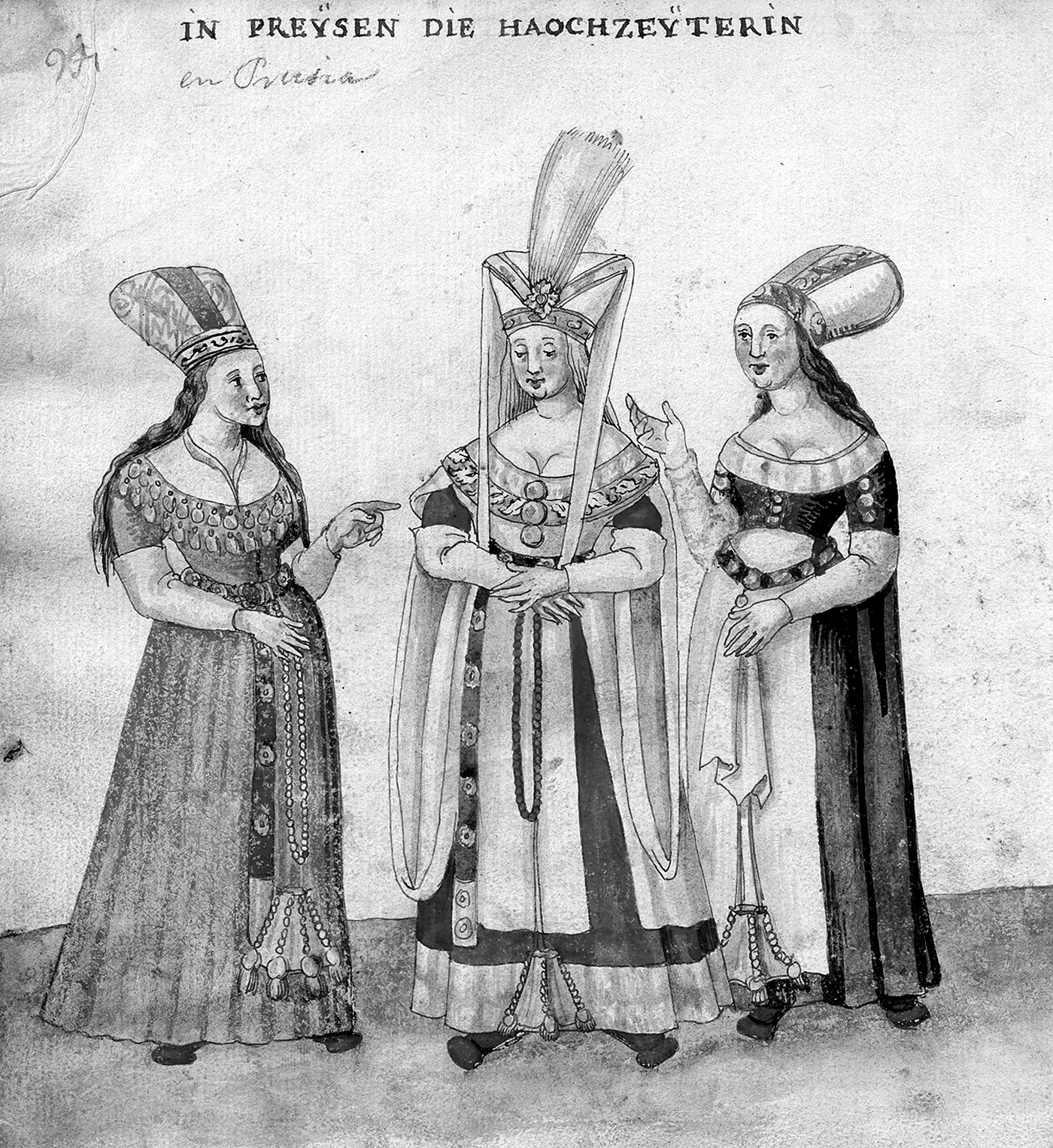
Figure 4. Prussian wedding party. Biblioteca Nacional de España, MS RES/285, fol. 50v. Photo: © Biblioteca Nacional de España.
Sternsee combined his interest in costumes and customs with subjects that concerned him personally and that related back to his life experiences. These were negotiated by his travels, his participation in several notable military campaigns, and his attendance at significant political events including an imperial coronation, as well as numerous imperial diets and aristocratic banquets. For instance, in 1546 he served as a guard at the chapter meeting of the Order of the Golden Fleece in Utrecht.Footnote 12 The album presents a double-page procession of knights from the order, accompanied by detailed textual description of the protocol surrounding their ceremonial apparel (fig. 5). He observes that crimson velvet robes, mantles, and hoods are worn on the first day “when in gala.”Footnote 13 The same apparel is then worn in black velvet but without the mantle to mourn the passing of former members. Finally, the knights wear white damask robes with red hoods to mark the election of new brothers to the order. At the helm of this chivalric order was Charles V. In the role of grandmaster, the emperor headed the pervasive, symbolic world of decorations and honors that became increasingly important in early modern Europe.Footnote 14
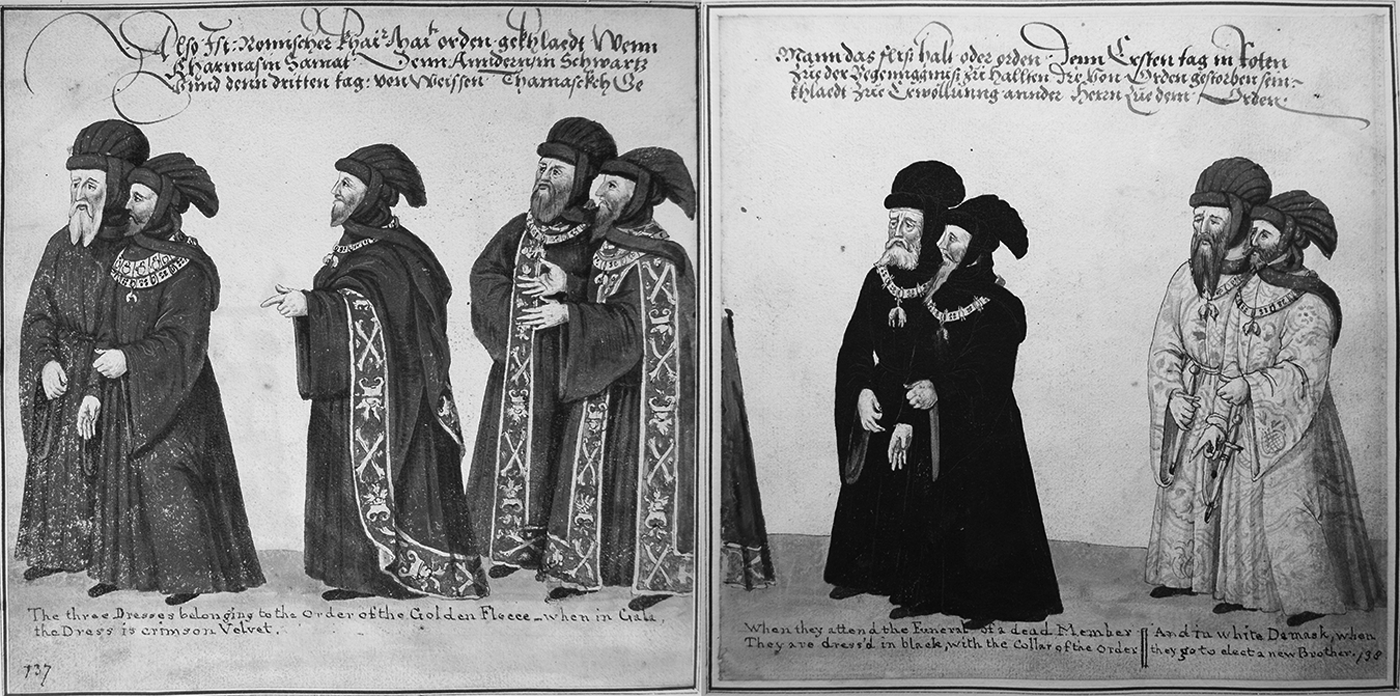
Figure 5. Procession of the Order of the Golden Fleece. Reference BuchananMuseo Stibbert, MS Cat. 2025, fols. 137–138. Photo: © Museo Stibbert.
Sternsee’s commission was unparalleled in its commitment to commemorate his experiences. Between 1525 and 1555 Sternsee kept a 415-page logbook, “Historia rerum in aula et ab exercitu Caroli V. gestarum a. 1525–1555” (A history of exploits in the court and army of Charles V, 1525–55) through which these features of his biography can be reconstructed.Footnote 15 An important historical record, the logbook documents his movements, chronicles military campaigns, and discusses current political affairs, while evidencing his astonishing rise in station. Sternsee’s travels afforded him cultural capital valuable to the enhancement of his rank. His awareness of this is demonstrated in his diligence to accurately log the names of every town he visited and the miles traveled between pit stops. In January 1551 he proudly listed every destination he had visited to date, calculating a total of 445 cities and eighteen islands traveled across a distance of roughly 5,034 German miles.Footnote 16 Like his album, the logbook highlights allegiance to the house of Habsburg in whose service he had come to be immersed in different courts, cities, cultures, and languages. The commemoration of Sternsee’s association with Charles V marks his album out from later printed costume books, while its documentation of clothing customs constituted an important antecedent.
As Ann Rosalind Jones and Margaret Rosenthal argue, early modern travelers like Sternsee observed “richly meaningful signs of shared cultural identity” in the clothing of diverse territories.Footnote 17 Consequently the practice of codifying sartorial customs through representative costume figures became the prevailing method through which to examine human difference on the increasingly vast and complex geopolitical stage.Footnote 18 Costume figures in characteristic apparel populated the margins of maps, lined the pages of travel accounts, and illustrated pamphlets advertising discoveries across the oceans.Footnote 19 Georg Braun and Franz Hogenberg’s atlas series Civitates Orbis Terrarum (Cities of the world, 1572) populated its topographical cityscapes with costume figures, while Pieter van den Keere’s world map of 1611 deployed costume figures within its bordering frame.Footnote 20 Hans Burgkmair the Elder’s woodcut frieze The Peoples of Africa and India was an important forerunner to the costume book, and pictured the Tirolese merchant Balthasar Springer’s voyage to India via the Cape of Good Hope. Its representational strategy—assertive titling, ethnographic nuance, and the indication of geographic movement with a pictorial panorama—formulated a comparative method through which to school, Sandra Young argues, “a growing readership in modes of representation and the taxonomical logic that later became associated with modernity.”Footnote 21 Epistemological authority came to be founded in comparative systems of analysis and rooted in experience-based evidence. The early costume albums of Weiditz and Sternsee pioneered close, comparative observation of cultural difference by recording the manner of different populations through their attention to dress, taking advantage of the semiotic capacity of clothing.
As the consumer demand for encyclopedic, instructive guidebooks of world dress flourished, costume books’ frequently derivative woodcut or engraved costume figures, arranged into moral geographies by savvy publishers, tended to become divorced from their original contexts. Beginning with Enea Vico’s (1523–67) engraved series of costume figures of ca. 1557, and followed by the costume book Le recueil de la diversité des habits (A collection of the various styles of clothing, 1562), the costume book became comprehensive, focused, and systematic. This development was not restricted to print, and plenty of hand-painted costume albums were produced in the second half of the century that, like their published counterparts, offered “armchair access” for owners curious about people abroad.Footnote 22 Volumes such as those compiled by Nuremberg official Sigmund Heldt (1528–87) and the Heidelberg church councilor Marcus zum Lamm (1544–1606) collected vast numbers of costume figures for this end.Footnote 23 Such works, which collapsed real-world information into pigment on paper, were portable collections that must have satiated desires like that expressed by English diplomat Sir Thomas Elyot (ca. 490–1546) “to beholde in his owne house every thynge that with in all the world is contained.”Footnote 24
Sternsee’s album is distinctive, defined by his personal travel itineraries and career aspirations. It relates to Weiditz’s Trachtenbuch in that it communicates cultural exchange and observation based upon travel and knowledge acquired through experience. The work served as a visual reminder of the diverse people and places Sternsee had encountered over his career, although its compilation of human subjects was not intended to be a precise log of peoples he had necessarily encountered, but an abstract demonstration of the sheer volume of cultures and customs he had been privy to. The tangible pride he demonstrated in gathering places and experiences in his logbook proved paramount to the commission of the costume album, which, in a similar vein, collected an impressive variety of subjects. The album conjured a sense of Sternsee’s worldly power over those who lacked experience of the wider world. Geographical knowledge and social connections buoyed by Habsburg contacts granted him intellectual expertise and cultural capital, strengthened pictorially through the album’s illustrations. Quickly and easily digestible to third parties in a way that his wordy logbook was not, the visually stimulating album offered the ambitious guard captain a product he could show off to courtiers and military men, as well as a valuable keepsake to be cherished by himself and his family. Sternsee’s efforts align with other contemporary practices that sought to understand and explain the natural world. He shared with his contemporaries a desire to collect, classify, categorize, and compare, in this case the people of different stations, cultures, and societies. Yet the album was a unique political project—a work that combined imperial propaganda with personal ambition. As the following analysis will demonstrate, it was Sternsee’s imperial service and his exchanges within Habsburg networks that empowered the album’s creation.
It emerges from Sternsee’s logbook that he served as a common mercenary in Charles’s first war against Francis I of France (1494–1547) in 1521.Footnote 25 During this period he was probably a young man in his early twenties, although the exact date of his birth is uncertain. A native of Carniola, a historic region encompassing large parts of modern-day Slovenia, Sternsee was born into a German-speaking family of the lesser nobility.Footnote 26 His hometown was Laibach (Ljubljana). When dismissed from service by the Duke of Milan following his participation in the Battle of Pavia, Sternsee returned to Laibach in March 1525 and began writing his logbook.Footnote 27 Shortly before Easter 1526 he returned to the Duchy of Milan on the emperor’s payroll, remaining there to secure the occupied Habsburg territory. In 1530 he entered the service of the Duke of Mantua, Federico Gonzaga (1500–40), and, after nearly four years in this role, he took up a post with the papal troops in Bologna. One year later news reached Sternsee that the emperor was amassing an armada to travel to Barbary, the European term for Northern Africa. Taking leave of the papal troops in April 1535, he joined a regiment of German mercenaries mustered in Spezia.Footnote 28 The campaign sought to recapture Tunis from the Ottoman admiral Hayreddin Barbarossa (ca. 1478–1546), who had been using the city as an advantageous foothold for conducting raids along coastal Mediterranean Europe. Sternsee’s experience of Tunis is detailed at length in his logbook and is a subject of significance within the costume album.
In Sicily, following the triumphant campaign, he launched a career with the German imperial guard of Charles V, where he remained for the duration of his life. Within five years of employment as an imperial Trabant (guard), Sternsee had risen to the position of captain, inheriting in 1540 the title and annual stipend of 100 florins from his predecessor. This privilege was paid to him by the Nuremberg municipal council until his death, and the ongoing correspondence between Sternsee and Nuremberg preserved in the city archives usually documents from where he was writing.Footnote 29 It provides a supplement to the logbook for piecing together his busy itinerary that, except on occasions of leave, saw him by Charles V’s side providing protection and military assistance.Footnote 30 Sternsee was a commander during the Schmalkaldic War of 1546–47, where he mustered, dismissed, and paid the wages of imperial troops.Footnote 31 When Charles based himself in Augsburg in the aftermath of this conflict and throughout the subsequent Imperial Diet of 1547–48, Sternsee was stationed in the city for ten months.Footnote 32 It was during this time that he seems to have gained inspiration for the costume album from a plausible encounter with the work of Augsburg-based portrait medalist Christoph Weiditz.
Weiditz’s comparable Trachtenbuch drew upon material he had collated between 1529 and 1532 when he sought out an audience with Charles V in Castile.Footnote 33 Weiditz’s motivation for his album appears to have been similarly provoked by traveler’s curiosity, inspired particularly by the wealth of regional costumes differentiating the various peoples of Iberia. Recording not only clothing styles but detailing customary conduct such as acts of penitence, law enforcement, and seasonal labors, Weiditz fashioned a visual argument for the relationship between dress, comportment, and social identity that reverberated in costume books and albums that followed. Weiditz resettled in Augsburg in 1532 following several years of journeying in the company of the imperial entourage, producing portrait medals for courtly elite across Spain, Germany, and Brussels. His beautifully finished pen and watercolor drawings, enhanced with silver gilding, were developed in the ensuing years from presumably quite rough travel sketches.
It has long been presumed that Weiditz created the Trachtenbuch for his own benefit. His authorship was concluded by Hampe because of the self-portrait Weiditz inserted into the album with the description, “Thus Stoffel weyditz voyaged over the sea with Kolman Holmschmidt.” Little attention has been paid by scholars to the presence of Kolman Helmschmid (1471–1532), Augsburg’s foremost armorer, in the narrative of the Trachtenbuch. Weiditz joined the mature and highly regarded imperial armorer on his trip to Toledo in 1529, and this facilitated his introduction into courtly circles.Footnote 34 A crucial piece of evidence that elevates Helmschmid to the potential protagonist of the Trachtenbuch is found in an early seventeenth-century copy, which contains a portrait of the armorer long since missing from Weiditz’s original.Footnote 35 The blacksmith carries his hammer and complements Weiditz’s portrait, on whose left he stands; the description reads, “In this manner the honorable Kolman Helmschnit traveled across the sea to Portugal and afterward to Spain to his Imperial Majesty who treated him honorably and well thanks be to God.”Footnote 36 Rereading the description of Weiditz’s portrait, it is clear that he is positioned in a supporting role. While Helmschmid died in 1532, Weiditz may potentially have been commissioned by Helmschmid’s son Desiderius Kolman Helmschmid to paint an album to memorialize his late father’s journeys across Europe in the service of the emperor.
Whether it remained in the possession of the Helmschmid family, Christoph Weiditz, or another party altogether, the Trachtenbuch does not appear to have left the city of Augsburg in the second quarter of the sixteenth century. Aric Chen has identified, for instance, that derivative imagery sourced from the Trachtenbuch is present in Enea Vico’s engraved series of costume figures (1557) because of the Italian printmaker’s probable encounter with Weiditz’s work during his visit to Augsburg in 1550.Footnote 37 It is highly conceivable that the work also became known to Sternsee during his ten-month stay in the city. A Habsburg favorite like Desiderius Helmschmid, who produced many suits of armor for Charles V, would easily have drawn the attention of an imperial servant like Sternsee. The same could be said for Weiditz because of his past experience in the imperial retinue and his operations as an accomplished portrait medalist for Augsburg patricians. Sternsee would have been struck by the Trachtenbuch, perhaps identifying it as a novel visual medium that he could put to use to demonstrate his worldly experience. Although the opportunity in Augsburg to have seen Weiditz’s work explains Sternsee’s inspiration for the commission, the strong stylistic parallels and derivative costume figures between the two albums suggests the appraisal of an artist.
Jan Vermeyen, whose relationship to Sternsee’s album will be analyzed in due course, was working at the Brussels court when Weiditz was placed there in the years 1531–32. They shared patrons and made portraits in oil and in bronze for two important Habsburg officials: Francisco de los Cobos (1477–1547), Charles V’s Spanish secretary, and the imperial chancellor Alfonso de Valdés (1490–1532).Footnote 38 Operating within this courtly environment, Weiditz may have shown his Dutch peer the current state of his costume sketches, triggering Vermeyen’s attentiveness toward regional costume when he embarked on his own travels in successive years. If Vermeyen made copies after some of Weiditz’s sketches, this visual material could have been among the corpus of Vermeyen’s source imagery, which resurfaces in Sternsee’s album. Its Morisco figures are unquestionably derived from those depicted in the Trachtenbuch (figs. 6–7). Other quotations include a mounted Spanish beadle, a rear view of a Basque woman spinning, and an escorted Spanish noblewoman wearing a long train held up by attendants.Footnote 39 This recycled imagery has been judiciously reworked so as not to be completely imitative; however, there is no doubt that Weiditz’s sketches provided the original source.Footnote 40 The style and composition of Sternsee’s album also evokes Weiditz’s earlier example. Both albums avoid background scenery, lay their figures out on grassy terrain, and label them according to their social and cultural identity, visually expressed through characteristic dress. Like the Trachtenbuch, Sternsee’s album depicts courtly elite and rural peasantry, urban citizens from recognizable centers across Europe, and divergent cultural groups in Iberia, such as the Andalusian Moriscos, indigenous peoples of the Americas, and inhabitants of the vast mountainous regions around the Bay of Biscay. Sternsee’s album added to these subjects the armorial folios, demonstrating familiarity with Europe’s political landscape, and included subject matter relating to the Tunis campaign and the captain’s imperial service more broadly.
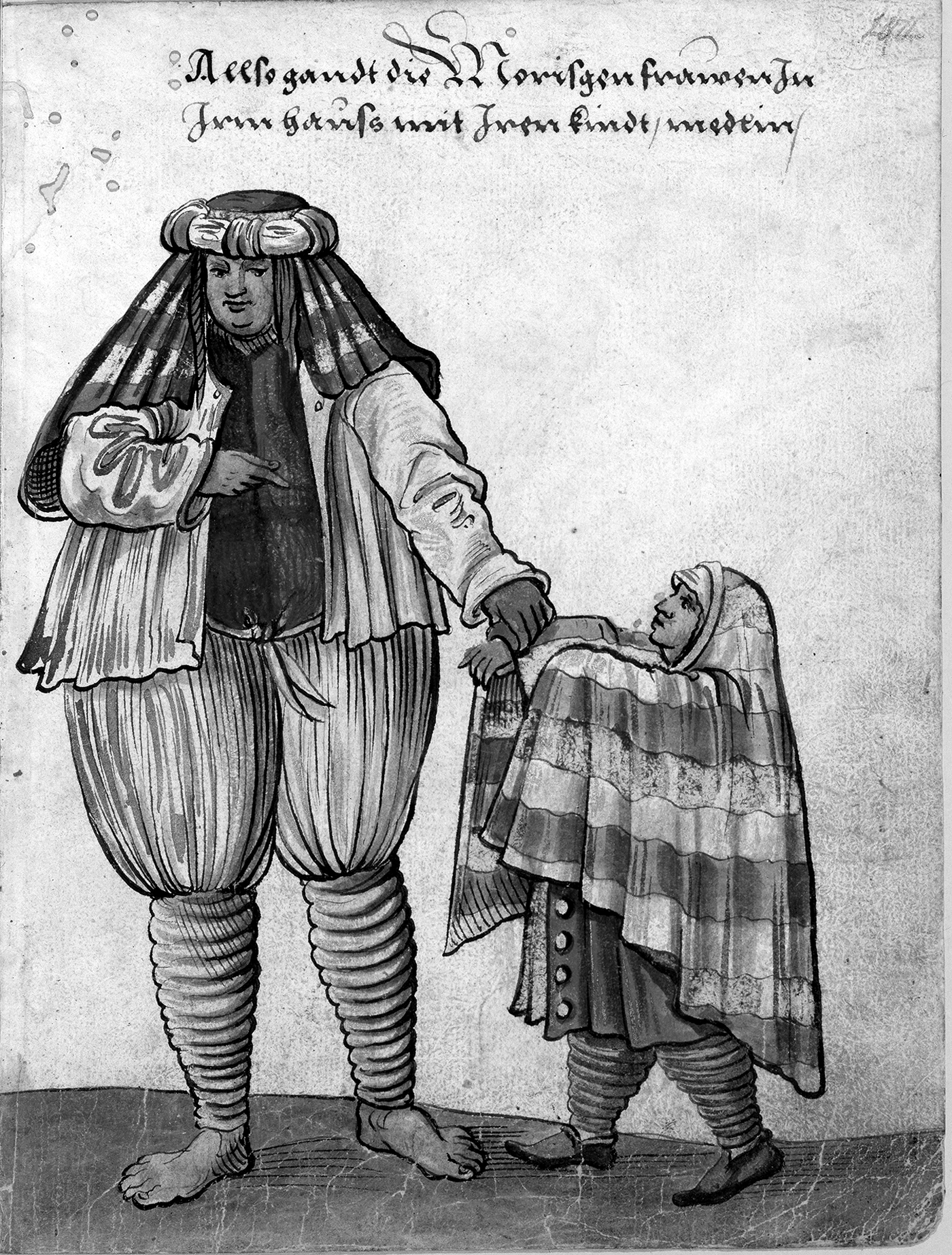
Figure 6. Christoph Weiditz. Moriscos from the Trachtenbuch. Germanisches Nationalmuseum, Hs. 22474, fol. 100r. © Germanisches Nationalmuseum. Photo: Monika Runge.
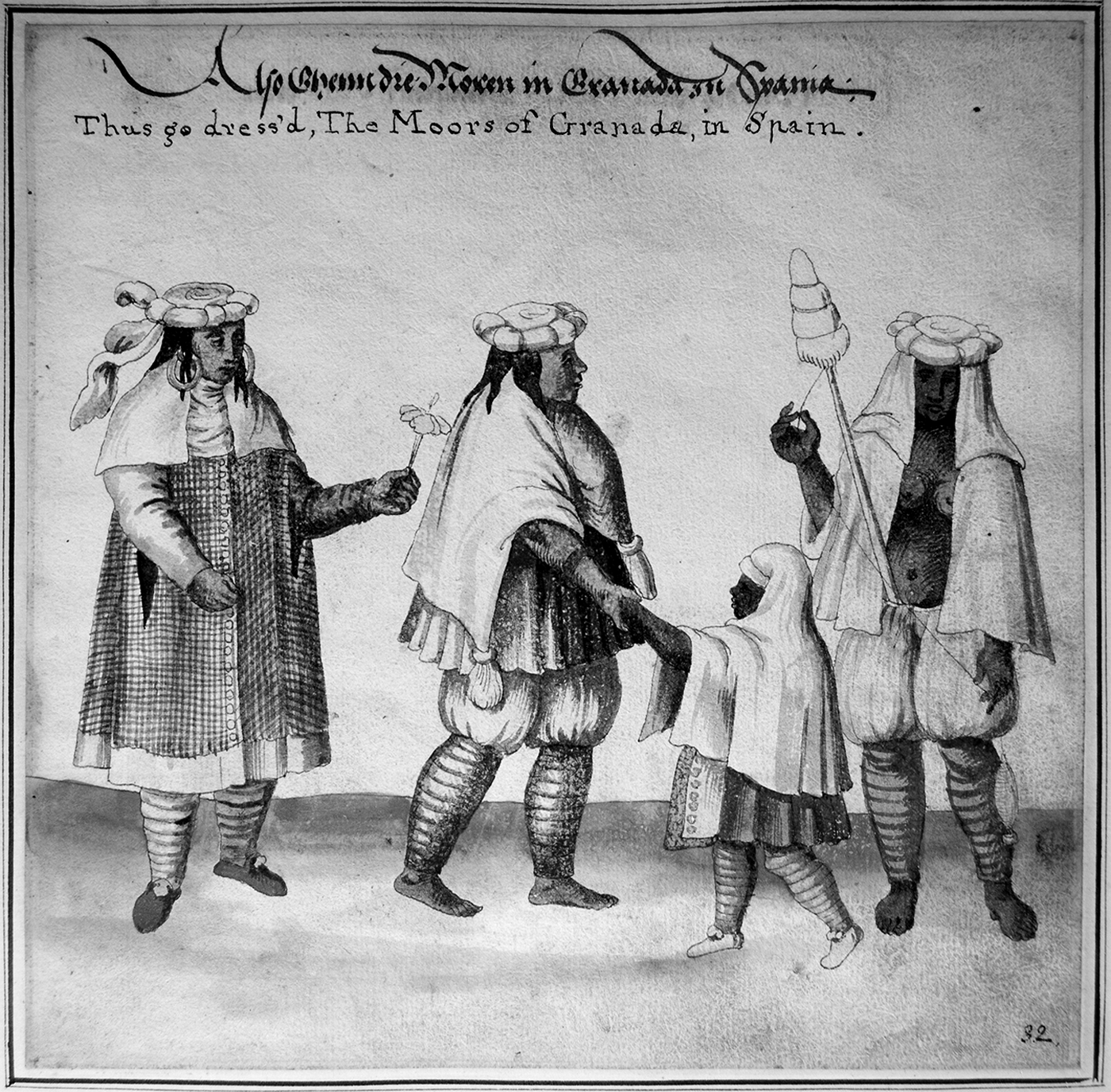
Figure 7. Moriscos of Granada. Reference BuchananMuseo Stibbert, MS Cat. 2025, fol. 32. Photo: © Museo Stibbert.
The Visual Program
The contents of Sternsee’s album bear witness to the extent of cultural exchange a Habsburg imperial military official could be exposed to. Charles V ruled over more territory across Europe than had been held since the height of the Roman Empire.Footnote 41 His reign ushered in a unique moment of history that symbolically united a great miscellany of culture, language, custom, and governance under a single, powerful sovereign. Citizens of Luxembourg and married women of Namur are mutually described in Sternsee’s album as belonging within the emperor’s hereditary dominions. The strange fate that they should have something in common with Amerindian people who “belong to the emperor” was momentous indeed, and captured Sternsee’s attention as he circulated around Habsburg domains.Footnote 42 Advisers, diplomats, and other court attendants were frequently transferred between Habsburg courts in spite of their varying geographic distance, encouraging the flow of culturally diverse peoples, practices, and ideas.Footnote 43 Charles’s court sponsored an assortment of ambassadors and was a spectacle of foreign cultures.Footnote 44 From 1520, Hafsid princes from the Tunisian nobility were subsidized at court. Because of this relationship, Charles was called upon to recapture Tunis from Hayreddin Barbarossa in 1535 and was granted suzerainty over the kingdom as a result.Footnote 45 Nahua notables from New Spain traveled to their new sovereign’s Spanish court in the 1520s and 1530s and, along with feather-worked artifacts and brightly plumaged parrots, caused a sensation among courtiers, documented by Peter Martyr d’Anghiera (1457–1526) and Gasparo Contarini (1483–1542). As a hub for cross-cultural encounter, the Habsburg court inspired a taste for the evaluation of human cultures.Footnote 46
At the center of this milieu was the figure of the emperor himself. Of all the features in Sternsee’s album that instantiate Charles V’s global hegemony, the most powerful is an illustration of the emperor enthroned and flanked by the seven electors (fig. 8). Positioned directly before pages containing the arms of German principalities and costume figures, it reinforces the authority Charles desired in the German lands.Footnote 47 Joachim Whaley argues that his interest in the German lands was governed by the crucial importance of gaining the imperial title that would “unite the various realms and give historical and theological legitimacy to the monarch.”Footnote 48 The legitimization of imperial power was witnessed by Sternsee when Charles was crowned by Pope Clement VII (r. 1523–34) in Bologna in 1530. He was not yet an imperial guard but a Habsburg soldier based in Mantua and was called out to the coronation to supplement the emperor’s security forces.Footnote 49 His logbook reveals curiosity and admiration for the pomp and ceremony he witnessed and comments on the vestments of Charles and the pope, as well as the clothing of heralds.
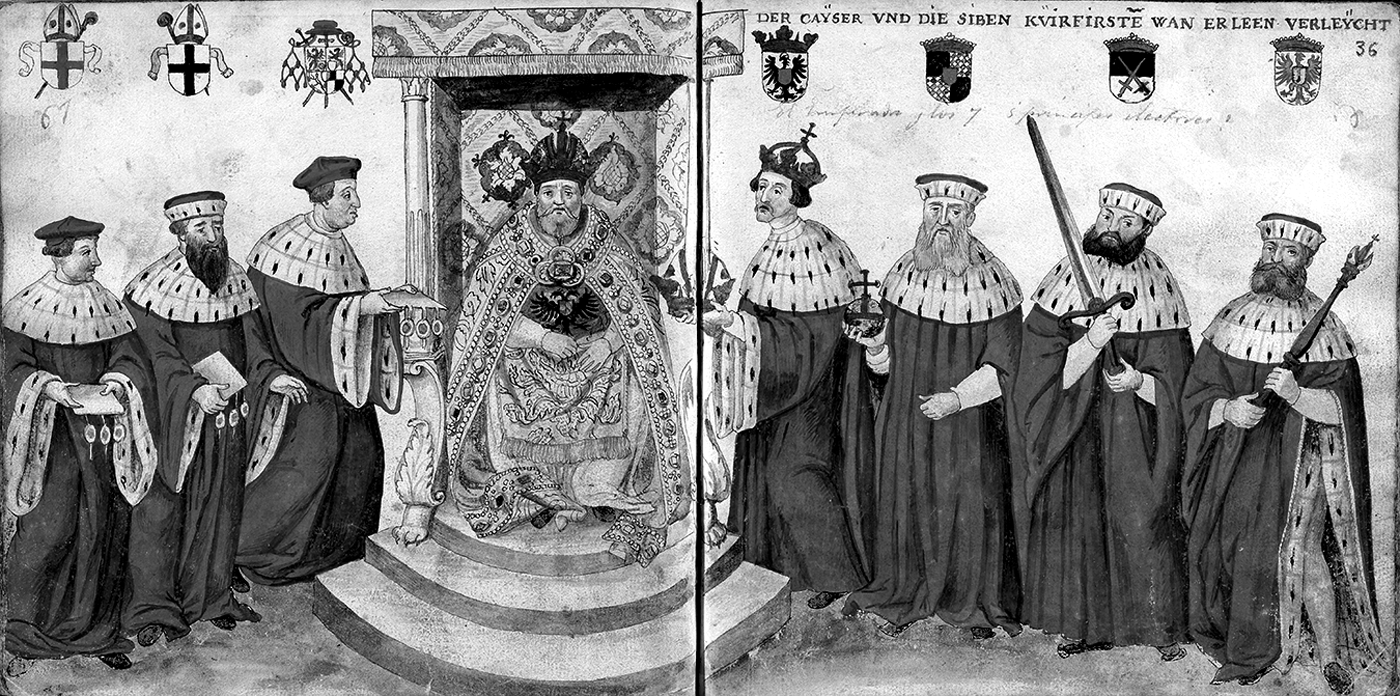
Figure 8. The emperor Charles V enthroned. Biblioteca Nacional de España, MS RES/285, fols. 35v–36r. Photo: © Biblioteca Nacional de España.
The illustration is not an accurate representation of the coronation of the emperor by the pope—the electors were notably absent from the event, and the pope is notably absent from the image. It is rather a symbolic portrayal of Charles’s investiture.Footnote 50 It commemorates the vested authority of the seven German electors, whose votes secured Charles the throne in 1519. The four princely electors and the three ecclesiastical electors, the archbishops of Trier, Cologne, and Mainz, are identified by the coat of arms of these electoral offices. As individuals, the figures share portrait likenesses not with the electors of 1519, but rather those who held these offices during the mid-1540s. Ferdinand I, king of Bohemia, is easily identifiable by his distinctive hooked nose. The elector of Saxony resembles portraits of Johann Frederick I (r. 1532–47), distinguishable by his broad, square beard and moustache, while the elector of Mainz, Albert III of Brandenburg (r. 1515–45), appears as an older version of his 1526 portrait by Lucas Cranach the Elder (ca. 1472–1553), with his characteristic double chin.Footnote 51 Frederick II, Count Palatine of the Rhine (r. 1544–56), is identified by a lengthy light-gray beard, as is seen in his 1545 portrait by Hans Besser, while Joachim II Hector, the elector of Brandenburg (r. 1535–71), sports his distinctive short brown beard.Footnote 52 While the depiction of particular individuals was eschewed in later costume books, this feature of Sternsee’s album buoyed his reputation by demonstrating knowledge of the elite circles of the period’s political movers and shakers.Footnote 53 The electors’ likenesses, however, contrast with the generic representation of the emperor, whose characteristic looks and jutting Habsburg chin are not defined. This may have intended to stress the universality of the title, or perhaps to flatter the aging Charles, whose graying beard does not reflect his age at the time of his election or coronation, but rather his mature age around the time of the costume album’s commission.
The album’s portrayal of the Order of the Golden Fleece demonstrates Sternsee’s admiration for the chivalric, knightly order and underlines his own aspirations for social and political advancement (fig. 5). It is clear that Sternsee was impressed by the recent spectacle of the 1546 chapter meeting, and his logbook reveals intimate knowledge of the goings on inside the meeting’s various venues.Footnote 54 Central to the fashioning of these Christian knights, who principally derived from Europe’s most distinguished nobility, were the order’s ceremonial dress codes. Various testimonies confirm the accuracy of Sternsee’s vivid pictorial and textual descriptions, which correspond, for example, with the account given by the English ambassador Stephen Gardiner (ca. 548–55), who accompanied King Henry VIII (1491–1547) to the 1546 chapter.Footnote 55 The solemnity of the order’s manifold robes, collars, and hoods was such that Gardiner notes that the knights received a sermon regarding their symbolic functions from Philip Nigri, the order’s chancellor (r. 1531–62).Footnote 56 Sternsee appears to have correspondingly schooled his artist in the representative weight of these regular costume changes. The order’s emblematic pendant of the pelt of the golden ram, depicted so prominently upon the knights’ robes, referred to the golden ram of Phrixus from the Greek story of Jason. This classical, heroic quest encouraged the order’s crusading spirit, and Charles V was barely ever depicted without the emblem.Footnote 57 Defense of the faith was the knights’ principal obligation and corresponded with the crusading ideals that led to the sack of Tunis. The Order of the Golden Fleece consequently epitomized Charles’s spiritual, imperial, and military duties, which shaped the networks Sternsee participated in and the ambitions within which he was enmeshed.
Habsburg court culture and Charles’s imperial, militarist agenda consistently shapes Sternsee’s album. The colonial presence in the Americas is a defining feature here, felt at court by the circulation of artifacts and people from lands newly incorporated into the empire. Sternsee’s album depicts eight Amerindian subjects. The first three are a family group whose feathered apparel positions them within an established pictorial tradition for the portrayal of New World people that had existed since the turn of the sixteenth century.Footnote 58 The Stibbert manuscript writes of this image, “Thus go the men and women in India, who belong to the Emperor, they stick Jewels in their faces, and have mantles made of feathers of parrots.”Footnote 59 The word belong is a compelling expression of Charles’s sovereignty over these people, while the reference to feather garments and jeweled face accessories probably followed Vespucci’s accounts of Brazil’s Tupinambá people.Footnote 60 By the 1540s, Brazil was in the firm possession of the Portuguese, and this caption may have been a competitive insinuation of Charles’s hegemony over the New World as a whole. However, it is more likely that the family group is generalized New World types and representative of the entire region, as distinctions between mainland Tupinambá people and those of other territories such as the West Indies would not have been comprehended by many on the European Continent.Footnote 61
The other five figures are depictions of subjects of “Newly-Found India” (fig. 9) and thus represent New Spain, the name given to the Spanish colonial territory that replaced the conquered Aztec Empire from 1522. Charles’s Spanish court hosted indigenous Nahua of the Aztec and Tlaxcala ethnic groups on several occasions. The most well-known party was the delegation of 1528, who were brought to Spain with Hernán Cortés (1485–1547) and subsequently depicted by Christoph Weiditz.Footnote 62 While Sternsee’s album replicated a number of Weiditz’s costume figures, it does not reproduce the latter’s corpus of jugglers, ballplayers, and noble emissaries popularly recycled by many successive costume books. Sternsee’s pictures nonetheless display an extraordinary level of knowledge about the specificities of Mexican garments, corresponding with pictorial examples from Mexican-produced codices produced prior to and during Spanish colonization.Footnote 63
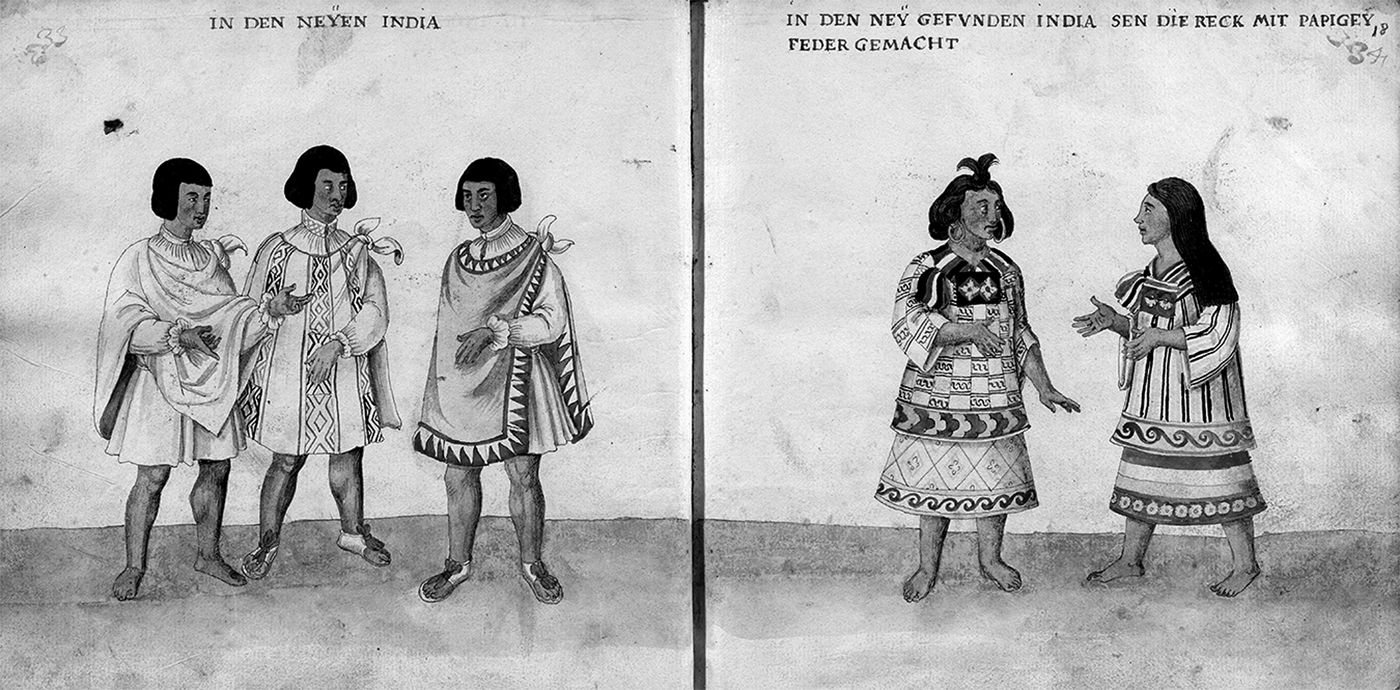
Figure 9. Figures from New Spain. Biblioteca Nacional de España, MS RES/285, fols. 17v–18r. Photo: © Biblioteca Nacional de España.
Many features suggest that visual information was gleaned from firsthand encounter and observation, altogether plausible for artists connected to the courtly world of Charles V. Lengthy stays from Mexican envoys were plentiful in the decades immediately following Spanish conquest.Footnote 64 Five Nahua noblemen from the 1528 group remained at court when their compatriots returned to New Spain and were financed at the Crown’s expense. In 1533 the Council of the Indies proposed to the emperor that they ought to “be doing something that would serve Your Majesty” as they were “here at Your Majesty’s expense,” and suggested they be split among the imperial chambers and the horse and foot guards.Footnote 65 It was not until 1537 that the last of this group, Hernando de Tapia, returned to New Spain.Footnote 66 The European-style shirts worn under the male figures’ cloaks (tilmatli) imply that the subjects of the illustration have been incorporated into a courtly environment. The Stibbert MS describes the male figures as the “first and richest Indians” who go dressed in silks.Footnote 67 This must refer to the shirts worn under their native cloaks, and may indicate the Spanish Crown’s efforts to financially support and outfit their noble guests, ensuring that gradations in status among sponsored parties would be duly recognized. The principal members of the 1528 group, for instance, were provided with luxury fabrics upon their arrival at the Spanish court.Footnote 68
The female subjects are described as wearing dresses (huipil) made of parrot feathers, although obvious feather shapes are eschewed. Mexican featherwork items that circulated into the hands of Gasparo Contarini, the Venetian ambassador to Spain in 1522, were crafted so finely and the feathers woven together so tightly that he marveled, “Never have I seen embroidery so lovely and delicate as some examples of this work.”Footnote 69 Mexican featherwork transformed the feather into a textile unmatched by anything known to Europeans. Woven together on looms, the feather’s natural shape was manipulated into a fabric with a delicate texture. If not for the descriptive text, the album’s dresses would surely be interpreted as constructed from colorful woven threads. This is a striking observation that suggests the handling and intimate knowledge of featherworked items and their complex surfaces and indicates that the creator of this image relied not merely on visual sources, but on artifacts and garments brought to European courts from New Spain. Given the lack of evidence suggesting Sternsee’s images were copied from a preexisting visual source, the chance that he or Vermeyen encountered Nahua and examples of their native dress at court is even more appealing. The Spanish court’s adoption of people and artifacts from New Spain put the Habsburg stamp on the region and ensured that evidence of imperial advancement in the Americas was on display. The region’s gold was imperative to Charles’s ambitious visions as his campaigns required exceptional financial support. His expedition to Tunis required such a large sum of money that it was only realizable with New World gold, for instance.Footnote 70
To counter Habsburg military and commercial hegemony in the Mediterranean, Ottoman naval forces had led attacks on the Italian coast in 1534 and captured Tunis from its Hafsid rulers. Charles’s campaign aimed to retake Tunis and secure his dominance over the Mediterranean. The imperial fleet sailed for Tunis on 14 June 1535. Declared a Crusade by Pope Paul III (r. 1534–49),Footnote 71 the Tunis campaign was emblematic of the triumph of Christendom over Ottoman adversaries. Sternsee served in the imperial infantry under the command of Marx von Eberstein while Vermeyen, in his capacity as campaign artist, famously sketched from within the fray. Sternsee’s logbook chronicles the expedition in full, reciting each key event from the pre-battle preparations to the siege of Goleta and the sack of Tunis.Footnote 72 The costume album shifts focus away from the campaign’s episodes and catalogues the dress, naval power, and wildlife on display in Tunis that proved to be so stimulating for Sternsee in 1535.
Five folios are dedicated to the Tunisian citizenry and paint a picture of a land whose honorable inhabitants wear fine fabrics, jewelry, and bodily decorations. One image depicts a pale noble maiden with red nails and gold hoop earrings escorted by a black footman appareled in a simple cape, while others, distinguished as “rich citizens,” stand in conversation (fig. 10). In another image, a mounted entry of the king of Tunis, Mulay Hasan, reinstated by the emperor following Barbarossa’s defeat, commemorates the successful campaign. His path is led by a man carrying a palm branch, a symbol recalling Christ’s triumphal entry into Jerusalem. His accompanying entourage, outfitted in golden tunics, carry long, double-pointed spears. Commentary consistent with Sternsee’s passion for measurements asserts that the spears are twenty-eight-feet long. The entourage resembles Berber cavalry in Vermeyen’s cartoons for the Conquest of Tunis tapestry series, commissioned in 1546 by Mary of Hungary (1505–58).Footnote 73 In fact, much of the visual content on Tunis in Sternsee’s album shares subject matter with the twelve-piece tapestry series, and was conceivably derived from Vermeyen’s original material.

Figure 10. Figures from Tunis (Barbary). Biblioteca Nacional de España, MS RES/285, fols. 15v–16r. Photo: © Biblioteca Nacional de España.
Nominal approval of the local Tunisian elite was a necessary outcome of Charles’s reinstatement of Hasan, who, owing his restoration to the emperor, was essentially a vassal king. The album’s favorable portrayal conceals the brutal treatment Tunis residents had been subjected to when the imperial troops seized the city and were given the customary right to pillage.Footnote 74 Sternsee’s logbook does not gloss over his participation in the bloodshed, reporting, “And so we moved into the city and plundered it, and beat 6,000 men to death, and led 12,500 women and children away, the others had run away, and freed 20,000 Christians who had been trapped there.”Footnote 75 In spite of this, the victorious campaign was remembered as one of the greatest military achievements of Charles V’s reign. It is fitting, therefore, to see a picture of a peaceful, well-ordered, and assumedly grateful Tunis citizenry free from the menace of Hayreddin Barbarossa. Habsburg associations with the Tunisian Hafsid dynasty were maintained and kept Sternsee’s attention. In July 1542 Sternsee documents the arrival at court of ambassadors from Tunis bearing tribute for the emperor, and in February 1548 the visit of the new king of Tunis to Augsburg at the time of the Imperial Diet.Footnote 76
Sternsee’s album also draws attention to the ships and crew of Charles’s armada, a fleet that was made up of nearly 400 vessels and 35,000 men.Footnote 77 Now preserved in the Stibbert MS, these images portray the “Great Galley” commanded by the famed Genoese admiral Andrea Doria (1466–1560), along with “the Carrack from Rhodes,” the Santa Anna, considered the largest ship in the world at the time. Depicted with its enormous, full sails flying, this impressive carrack was sailed by the Knights of Saint John and is described as having the capacity to carry 60 large cannon, 100 sailors, and 300 soldiers (fig. 11).Footnote 78 The album also presents a caravel belonging to the king of Portugal and galleys from the Habsburg and Ottoman side of the war. Different perspectives of these vessels in action emerge in Vermeyen’s tapestry designs, particularly in the spectacular naval battle scene in the Capture of La Goletta, where the Santa Anna reappears mid-skirmish with its sails firmly bound. Lisa Jardine and Jerry Brotton argue that Vermeyen appears to have been urged to observe and record precise naval and troop formations, accounting for the tapestries’ emphasis on military power and innovation.Footnote 79
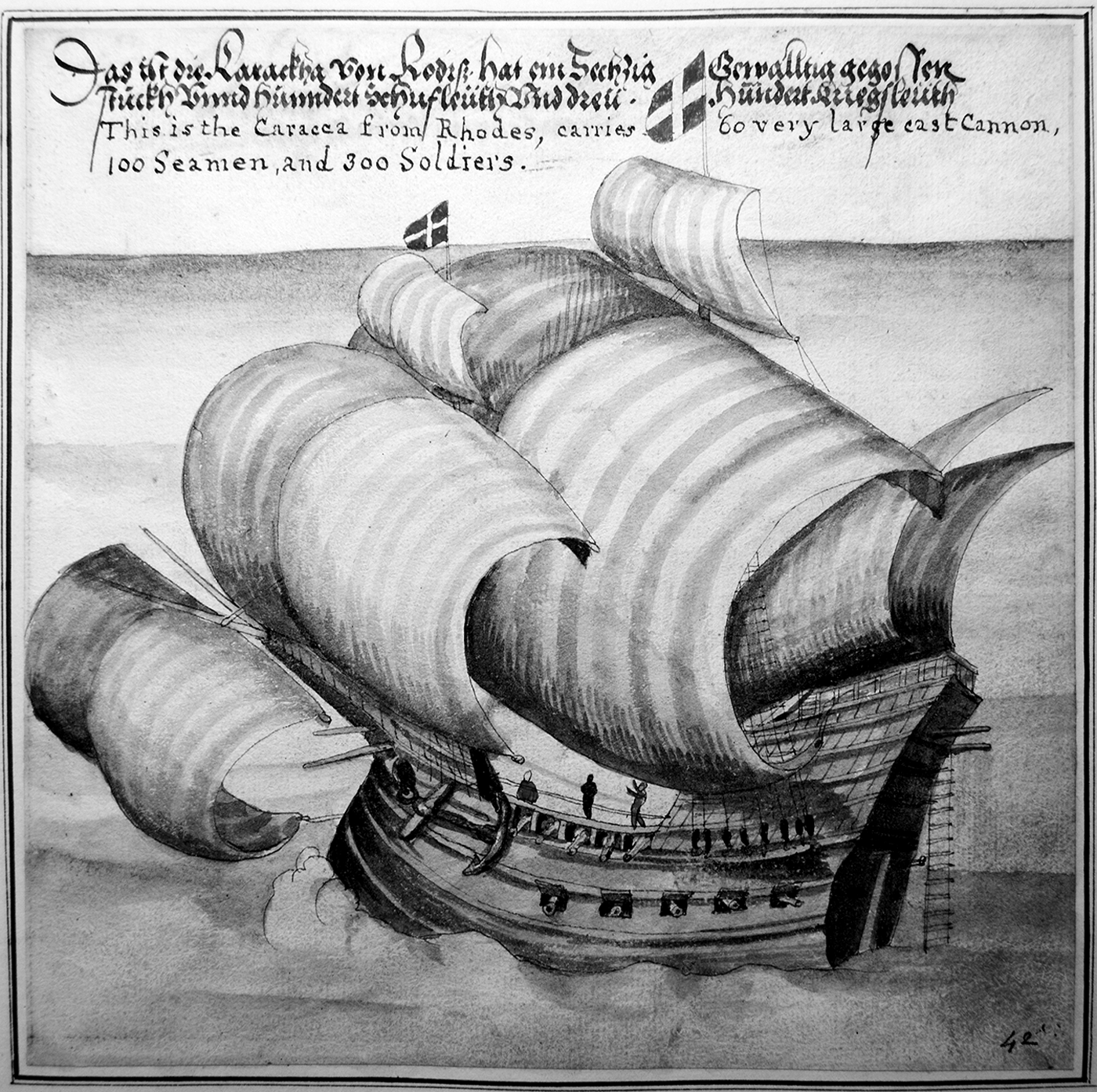
Figure 11. The carrack of Rhodes, the Santa Anna. Reference BuchananMuseo Stibbert, MS Cat. 2025, fol. 42. Photo: © Museo Stibbert.
The corresponding section in Sternsee’s album stresses the fearsome artillery power Charles V held at his command. It also presents the ships’ sailors, portrayed wearing red shirts and breeches, as well as fur-lined gowns to shield against the elements. Consistent with the tapestries, galley slaves are depicted with their heads shaved and probably represent the chained Anabaptists and other prisoners documented to have been brought from Antwerp to row the galleys.Footnote 80 Although the Tunis campaign is not explicitly mentioned in the captions for these images, they correspond with the naval muscle accumulated for this battle. The album’s scribe must have been versed in specific knowledge about the operation, as he provided information in several instances about the weaponry and manpower aboard the ships.Footnote 81 These observations relate to Sternsee’s lengthy descriptions in the logbook of ships’ sizes and their capacity to hold sailors, soldiers, and cannon.Footnote 82 One picture even recalls, “Thus the galleys, when they fall in with large ships and when they have no wind”—a problem surely recalled from Sternsee’s personal memory of the armada.Footnote 83
North African flora and fauna also enter Sternsee’s album, betraying his especial interest in the region. Again the album’s commentary is assertive, offering intimate knowledge acquired through direct experience. On one folio a Berber man is depicted riding a camel. “This is a Dromedary,” the caption knowingly relates, “which walks faster than a horse.”Footnote 84 Another explains, “Thus look the baboons, and monkeys, which are found in Barbary in great numbers, and do essential damage to the fruit.”Footnote 85 An illustration of ostriches with bushy feathers schools viewers that they “have this color, in Barbary” (fig. 12). Other animals include leopards, a black camel, a goat, and a scorpion, while an illustration of a date palm tree “with its fruit” demonstrates an interest in local plant life. Many of the North African animals presented in Sternsee’s album are also prominent in the Conquest of Tunis tapestries, specifically in the cartoon portraying the imperial forces moving camp after Tunis’s sacking, which depicts goats, bulls, camels, and ostriches being herded by imperial troops. Sternsee’s album finishes its nature section with a brief shift in location, presenting one folio of “Elephants in India, where are many Parrots, of all colors.”Footnote 86 This must represent an attempt to identify other foreign and fascinating wildlife that could add to the costume album’s global scope.

Figure 12. Ostriches of Barbary. Reference BuchananMuseo Stibbert, MS Cat. 2025, fol. 56. Photo: © Museo Stibbert.
Sternsee also experienced cultures that fell outside imperial authority. Although his album fosters a sense of the emperor’s omnipresence, the armorial folios, for example, meticulously register the coats of arms of sovereigns and territories extending across England, France, and Italy, and incorporate costume figures from these lands and the Ottoman Empire. These subjects gather together the applied knowledge of the political and cultural makeup of Europe and its surroundings that a Habsburg military official’s career could accrue. Sternsee faced French troops regularly throughout the Italian wars that preoccupied much of his career, and during a rare moment of peace between the frequently warring Charles V and Francis I in the winter of 1539–40, Sternsee followed the emperor to the Low Countries as he traveled with the Trabanten through Gascony and up past Paris by way of Orléans.Footnote 87 His curiosity was stoked by the local castles, churches, universities, and pleasure houses they passed, while the relics at the Basilica of Saint-Denis inspired his sincere admiration.Footnote 88 The album’s costume figures from the Kingdom of France comprise the southern populations in Bayonne and Gascony, where women attending church are enveloped in long, hooded cloaks. In the northern centers of Paris and Péronne, the fashion for folded hoods and turned-back, hanging sleeves is shown as dominant.
There is no sense of antipathy toward non-Habsburg subjects, whether allies or antagonists. At the time of the album’s commission, around 1548–49, two of Charles V’s most significant contemporaneous rivals—Francis I of France and Henry VIII of England—were recently deceased,Footnote 89 and replaced by young, untried sovereigns. This power shift in Europe’s political landscape is glimpsed in that the album lacks comparable depictions of the new French and English kings to complement that of Suleiman the Magnificent, enthroned and surrounded by courtiers dressed in splendid red and gold damasks. It was Sternsee’s business to be informed about important neighboring cultures and territories. The album reveals a genuine interest in portraying the nuances of apparel, accessories, and weaponry that set apart French, Italian, English, and Turkish subjects. While English ladies are depicted wrapping their chests and shoulders with thick, white linen, their Genoese counterparts were marked out by their beautiful, gold-latticed partlets. Like Sternsee’s logbook, the album avoids entertaining sensational positions on national character, politics, and religion, and objectively records subjects of consequence for an experienced Habsburg servant.
Visual Sources
The manner in which Sternsee’s costume project was realized is a challenge to piece together, although it is possible to draw conclusions about the artistic circle it emerged from, the date Sternsee commissioned it, and the relationship between the original album and its copy. Jan Cornelisz Vermeyen’s involvement in Sternsee’s album is detectable through a number of costume figures that have counterparts in Vermeyen’s oeuvre. This suggests he was a contributor to the album’s illustrations, which are either attributable to his workshop or to another artist within his Brussels-based circle. Like Sternsee, Vermeyen’s principal patrons were the Habsburgs. This relationship permitted him the opportunity to witness diversities of dress across Europe in the company of the imperial entourage. Compelling associations between Vermeyen and the costume album’s contents are appreciable, moreover, in his role as Charles’s dedicated campaign artist in Tunis.
Vermeyen’s association with the Habsburgs began around 1525 when, as a young artist, he entered the service of Margaret of Austria (1480–1530), Charles V’s aunt and regent of the Spanish Netherlands.Footnote 90 In 1530 he accompanied her to the Diet of Augsburg and then on to Innsbruck, where he executed a number of portraits of the imperial family for his patroness.Footnote 91 Painting Charles V’s portrait on this occasion launched his career as the “painter of the illustrious aforementioned Emperor, whom he accompanied as a fellow-traveler in diverse lands.”Footnote 92 At the 1530 Imperial Diet, Vermeyen had his first potential opportunity to cross paths with Christoph Weiditz. One year later, the two were to work in close proximity at the Brussels court—the same period during which Weiditz was compiling sketched material gathered during his recent trip to Spain, which would later form much of the content of his Trachtenbuch.Footnote 93 Vermeyen was to soon undertake significant travel of his own, producing sketches and finished works that documented the regional appearance of local people.
Vermeyen relocated to Spain sometime before 8 June 1534.Footnote 94 This was the date of a notable bullfight held in Avila, depicted by Vermeyen in a hurried pen and wash drawing (fig. 13). In the foreground of the sketch, on the far lefthand side, a series of women with elaborate headwear stand beneath and next to a wooden viewing structure. Most interestingly, these Spanish women resurface in Sternsee’s costume album (fig. 14), wherein the details of their dress and composition are closely aligned to the sketch. In both the album and the sketch, the backwards-turned figure wears her hair in a long, bound hair braid called a tranzado, extending from beneath her headdress.Footnote 95 A distinctive headdress is also worn by the woman who holds a feather fan. Called a tocado de papos, this popular garment enclosed the hair within two bulbous mounds of gathered fabric on either ear. This figure also sports voluminous sleeves tied with ribbons and a cone-shaped verdugado skirt, stiffened with hoops, in particularly Spanish fashion. Another woman wears a lengthy mantle over her head held down by a flat-brimmed sombrero. While the feet of the figures in the bullfight are not made visible within the mass of the crowd, they are depicted in the costume album wearing another distinctly Spanish fashion—chopines, or platform clogs, which were popularly adopted across Europe as the century progressed. Apparently striking him as particularly fascinating, characteristic garments of Spain, these fashions were depicted by Vermeyen in many other works from his oeuvre.Footnote 96 The June bullfight in Avila was attended by Charles V, and a trail of other works Vermeyen produced in this period suggest he was traveling alongside the imperial entourage as it moved about Iberia.Footnote 97 Spending at least a year in Spain before famously embarking with the imperial fleet to Tunis, Vermeyen had plenty of opportunity to observe his surroundings, which might explain why Sternsee’s album was able to visualize a disproportionate number of subjects from these parts with such nuance—for instance the scene depicting the method and tools rural Spaniards used to harvest and thresh corn.

Figure 13. Jan Cornelisz Vermeyen. The Bullfight at Avila, 1534. Aquatint on paper. Formerly of the collection of José Menédez Pidal; current location unknown. Reprinted photograph of J. Laurent from the journal La Esfera, no. 228, 11 May 1918. Photo: José Luís Pajares / Flickr, CC BY-NC-SA 2.0.
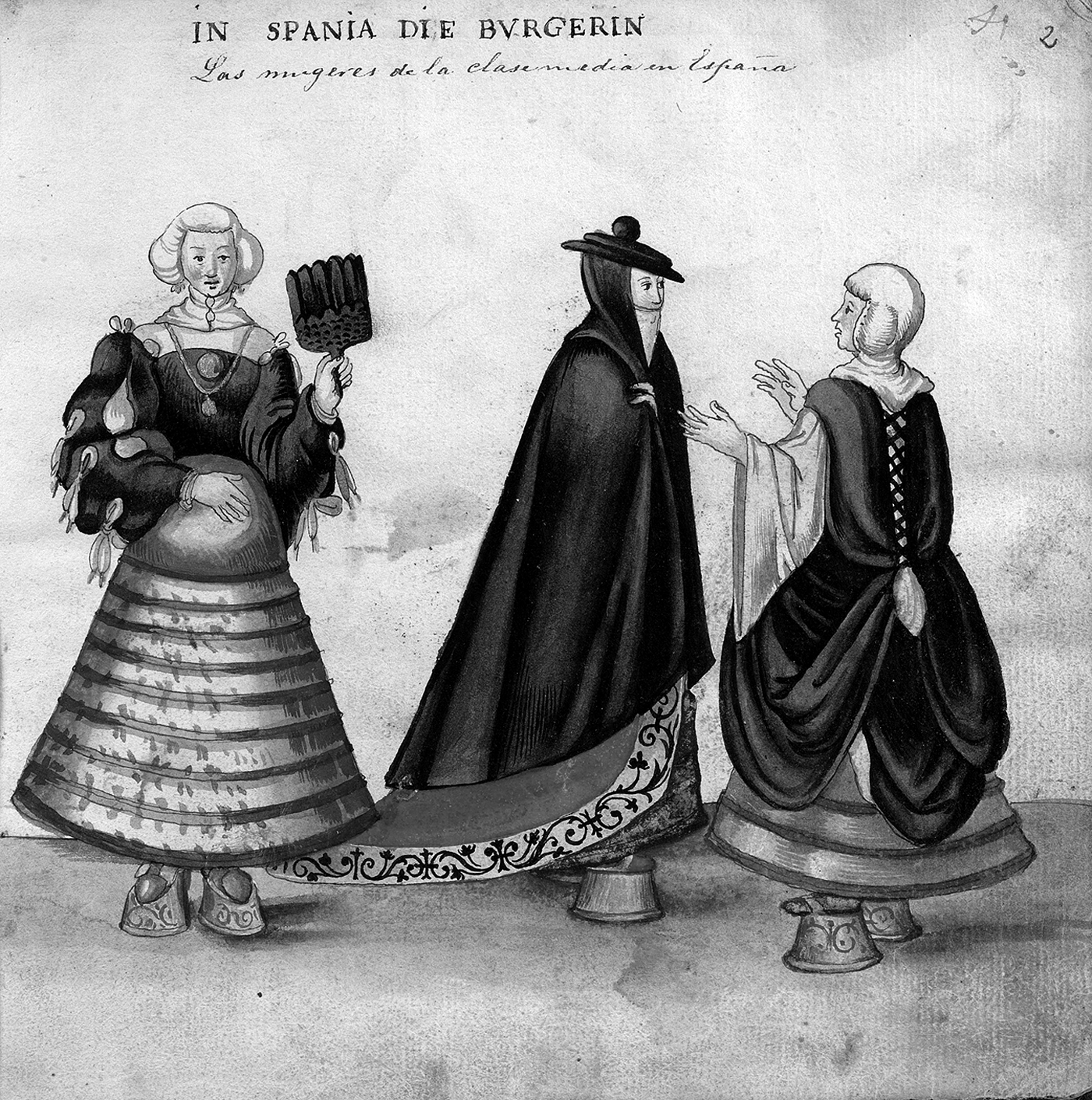
Figure 14. Burgher women of Spain. Biblioteca Nacional de España, MS RES/285, fol. 2r. Photo: © Biblioteca Nacional de España.
Vermeyen’s period in Tunis seems to have proved just as fruitful for Sternsee’s album and its visual attention to the region. The propagandistic value of the campaign was not lost on Charles V, who brought a dedicated artist into the field of battle. It is possible that Sternsee’s memory of the emperor’s war artist may have led to Vermeyen’s subsequent involvement with the costume album a decade or so later. Around the same time, Vermeyen was working on the tapestry cartoons memorializing the campaign.Footnote 98 The sumptuous Conquest of Tunis series, woven with the finest wool, silk, and gilt-threads, is today housed in the collection of the Royal Palace of Madrid. Iain Buchanan and Thomas P. Campbell have convincingly argued that the prominent tapestry designer Pieter Coecke van Aelst (1502–50) collaborated on the cartoons.Footnote 99 He was doubtless brought into the project to consult on tapestry composition because Vermeyen was new to the medium, and his influence is perceptible in stylistic parallels, including the reuse of foreground figure groups from Coecke’s existing oeuvre.Footnote 100
A couple of Turkish women featured in Sternsee’s costume album were almost certainly sourced from Coecke’s woodcut frieze The Customs and Fashions of the Turks, whose female figures wear the same style of gown with distinctive back panels embellished with hanging strings (figs. 15–16). The woodcut frieze was published posthumously by Coecke’s wife Mayken Verhulst (ca. 1520–60) in 1553,Footnote 101 and thus the appearance of these Turkish figures in the album points to their creation by someone with access to Coecke’s unpublished drawings around 1548–49, the proposed time of Sternsee’s commission. At this very time, Coecke was collaborating with Vermeyen on the Tunis tapestries. This relationship meant that Vermeyen’s workshop would have had this access, and vice versa, pinpointing the album’s production to these two artists and their students, or another Brussels workshop with whom they were on equally close terms. Although there was a long delay before the tapestries were commissioned, Vermeyen capitalized on his Tunis sketches in the years that followed, and obtained an imperial privilege in 1536 for printed material that demonstrated familiarity with Tunisian topography, inhabitants, and customs.Footnote 102 The material needed for the tapestry series was immense and could only have been the outcome of hundreds of sketches that Vermeyen had held on to.Footnote 103 These sketches and others made in Spain and elsewhere provided a range of stock figures that could be readily inserted into the tapestry series and Sternsee’s album in successive years.

Figure 15. Pieter Coecke van Aelst. The Customs and Fashions of the Turks, 1553. Woodcut on paper. Rijksmuseum RP-P-OB-2304H. Photo: © Rijksmuseum, Amsterdam.
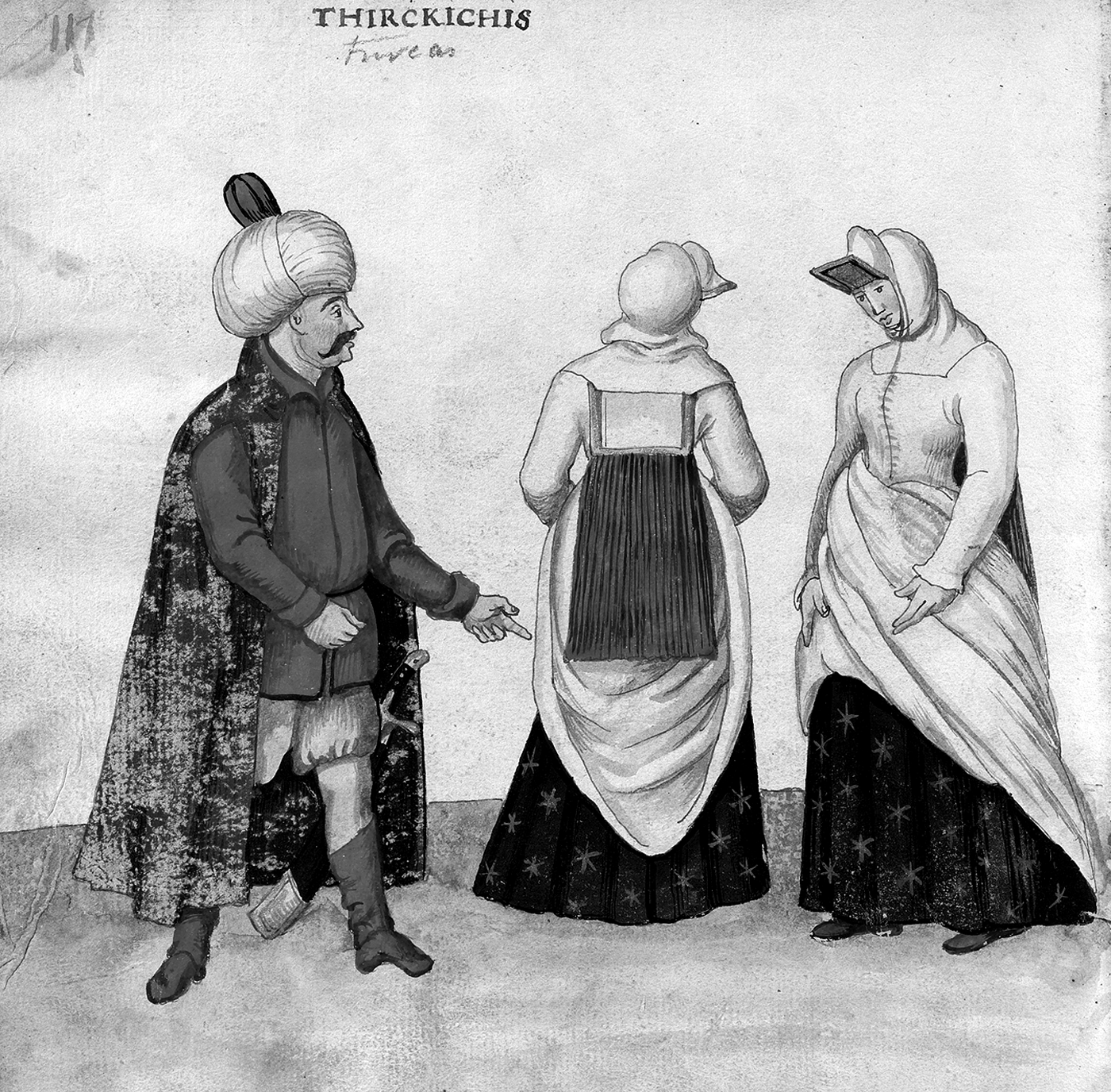
Figure 16. Turkish figures. Biblioteca Nacional de España, MS RES/285, fol. 62v. Photo: © Biblioteca Nacional de España.
The Conquest of Tunis cartoons share a number of counterpart figures with the costume album. In the cartoon depicting the campaign’s end, three dancing Spanish women correspond with a similar subject in the album (figs. 17–18). The dancing groups parallel each other in movement and gesture and wear hitched-up overskirts, white tocado de papos headdresses, and tranzado braids. One of the dancers holds a peculiar box-like object above her shoulder. A mysterious item, it seems to have been a dancing accessory, possibly a rattling instrument, and it reappears in Vermeyen’s etching The Spanish Brothel (1545).Footnote 104 In the same cartoon (fig. 17), to the right of the dancers, a woman is escorted by two men. She appears remarkably like the Castilian woman with her fan in Vermeyen’s Bullfight at Avila, who, it was noted earlier, reemerged in the costume album. Vermeyen seems to have sourced visual material for the monumental tapestry commission from his own back catalogue of pre-Tunis subjects. From among this very same set of sketches and finished works the Sternsee album appears to have drawn ample imagery.
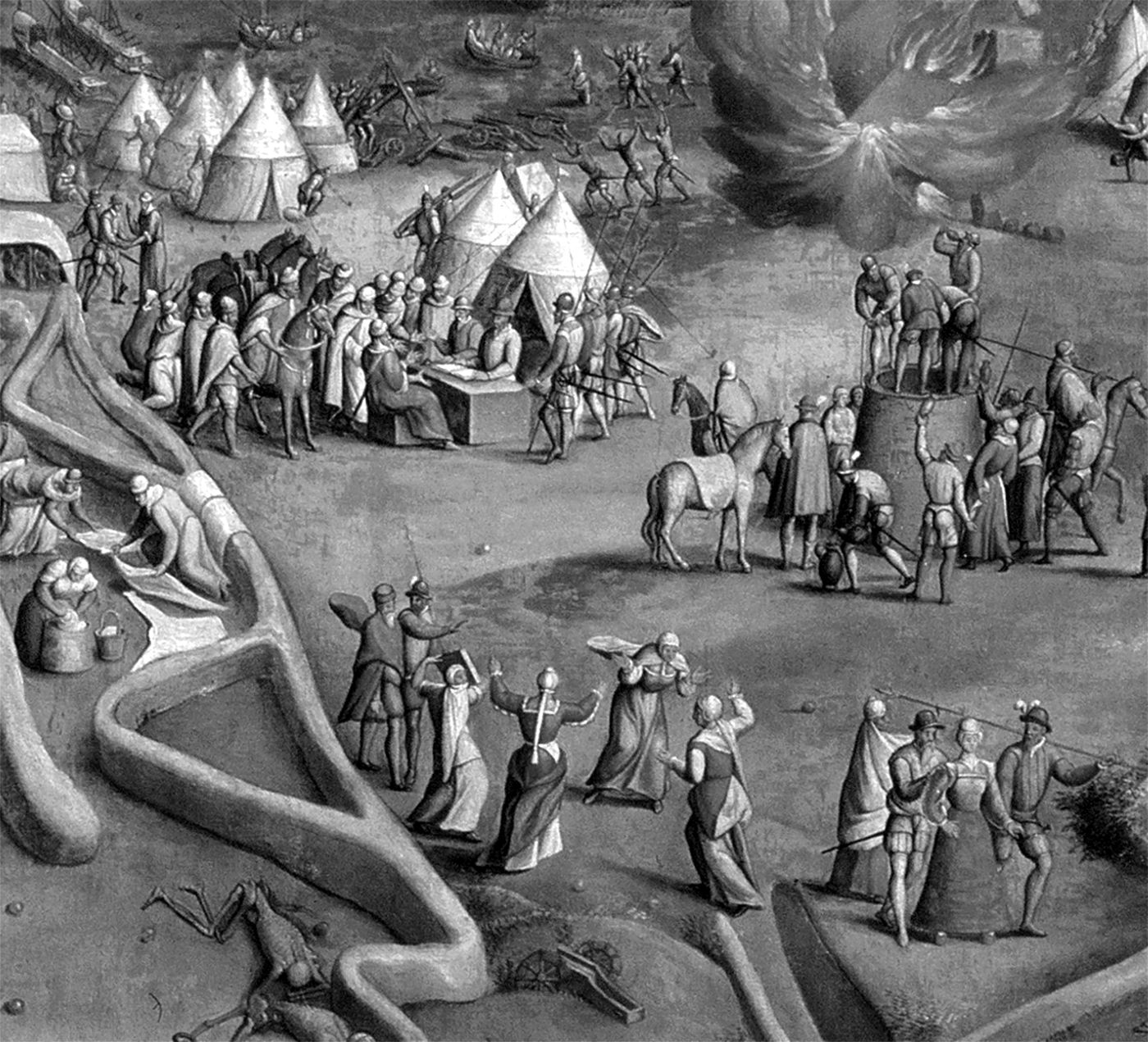
Figure 17. Anonymous, after Jan Cornelisz Vermeyen. The Re-embarkation at Goleta (detail), copied after the Conquest of Tunis tapestry cartoons, 1546–50. Oil on canvas, 116.8 × 201.4 cm. Coburg, Kunstsammlungen der Veste Coburg, Inv. M.048. Photo: © Kunstsammlungen der Veste Coburg, Germany.
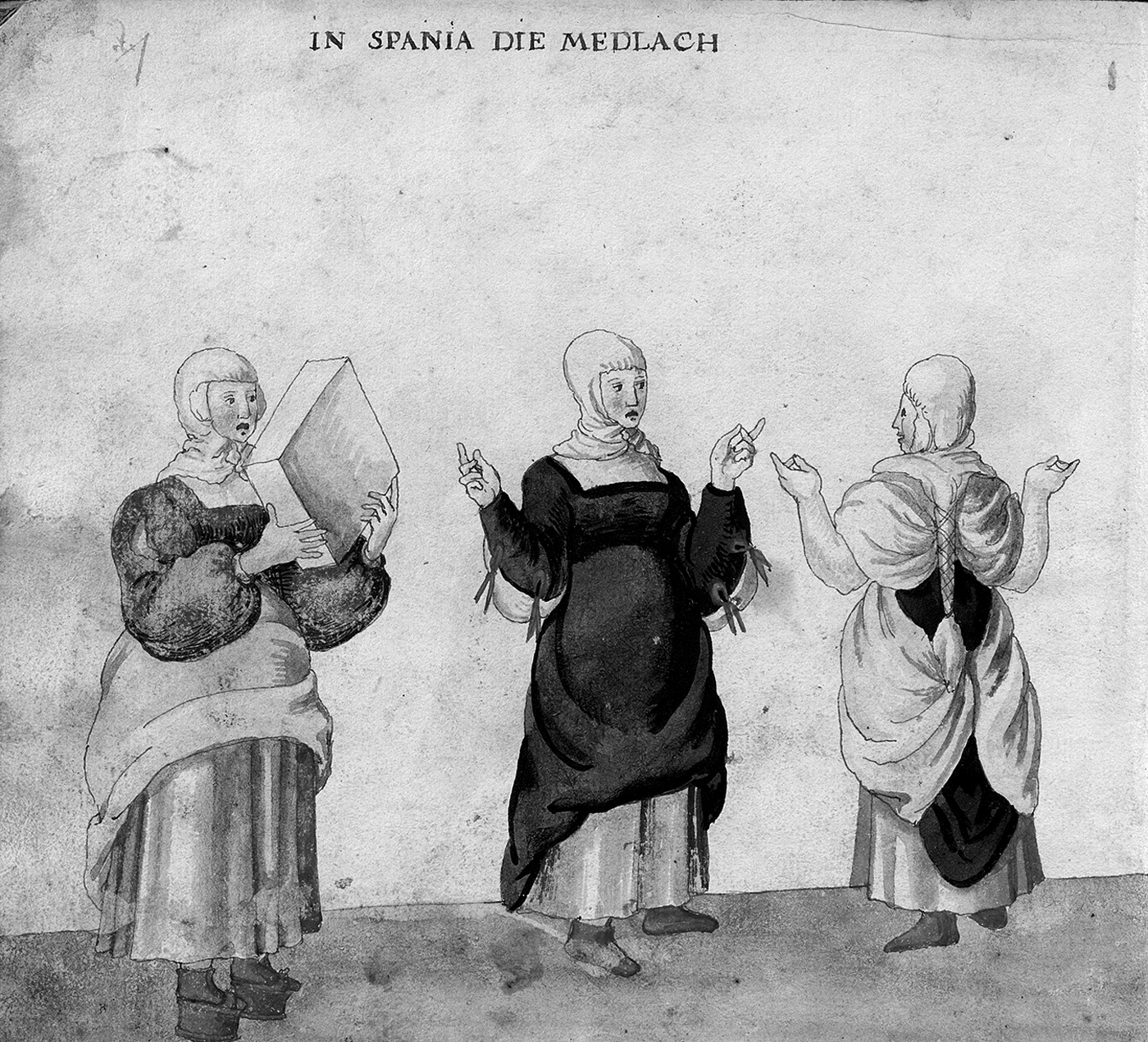
Figure 18. Spanish middling women. Biblioteca Nacional de España, MS RES/285, fol. 3v. Photo: © Biblioteca Nacional de España.
Sternsee’s album shares with Vermeyen’s tapestries a tangible concern to differentiate the enemy forces involved in the campaign, and repurposes three compositions from Jan Swart van Grönigen’s (ca. 1495–ca. 1563) woodcut series of Suleiman I and his entourage (Procession of Ottoman Soldiers, 1526) to help meet this end. At the time of Charles’s invasion, Tunis consisted of inhabitants descended from the indigenous, seminomadic Berber population and from Muslim Arab invaders, present in the area since the Middle Ages.Footnote 105 In his logbook Sternsee refers to the North African forces of Tunis as “Moors” in distinction to the “Turks.” The costume album depicts the soldiery of the former wearing a style of turban with hanging fabric enveloping the neck. Different groups within the Ottoman army, whose defense of the city brought a multitude of fighters into the cultural mélange of the campaign, are identifiable through diversities of uniform. Janissaries, the elite soldiers of the Ottoman infantry traditionally recruited from prisoners of war, wear their cylindrical drooping hat called the börk. The Albanian cavalry are identifiable by their high top hats, while the Mamluk forces don tāquiyya—domed, shaggy hats. The Turk forces, meanwhile, wear voluminous folded turbans. A comparable commitment in Vermeyen’s tapestry designs to differentiate between the costume of Turks, Berbers, Germans, and Spaniards makes it possible to follow the battle narrative. The extent of ethnic diversity demonstrated here and in the costume album exhibits the manifold peoples on both sides of the campaign who had been assimilated into the expanding Ottoman and Habsburg empires. Hendrik J. Horn speculates that Vermeyen returned to Spain after the Tunis campaign, traveling with the emperor through Italy, France, and into Spain, arriving in 1537.Footnote 106 Christoph von Sternsee, the newly minted guard, took this same journey back to the emperor’s court in Valladolid, where he and Vermeyen remained, in Castile, in their respective roles before accompanying the emperor to the Netherlands in December 1539.Footnote 107 Their shared courtly networks exposed them to similar customs and events, and may even have brought them into acquaintance.
In March 1539, Vermeyen signed and dated a painting of a festive Moorish tourney he attended in Toledo.Footnote 108 The juego de cañas, or game of canes, was a traditionally Moorish tournament game that continued to be practiced in Christian Iberia on important, ceremonial occasions.Footnote 109 Sternsee’s album begins its section of Spanish figures with a pair of juego de cañas riders (fig. 19). Dressed in Moorish turbans and tunics called marlota, and bearing traditional heart-shaped leather shields called adargas, the two riders hurl blunted spears at one another.Footnote 110 This image is thus consistent with the costume and action of a typical sixteenth-century games of canes, characterized by quadrilles of equestrian riders in Moorish livery casting light reeds at each other before retreating.Footnote 111 Although Sternsee does not mention attending such a tournament in his logbook, he was surely familiar with Iberian juego de cañas as a result of his placement at the Spanish court. As Barbara Fuchs explains, the game of canes was a distinctive spectacle that impressed foreign observers with its display of skilled horsemanship, exotic liveries, and all-around pomp.Footnote 112 It also served the emperor as a means “to display Spanishness abroad,” she contends, noting that a game was organized at Charles’s imperial coronation in Bologna to the delight of the Venetian observer Marco Antonio Magno, who exclaimed that “it was the most graceful, elegant, sumptuous, and stately sport ever performed in Italy.”Footnote 113

Figure 19. Juego de cañas rider. Biblioteca Nacional de España, MS RES/285, fol. 1r. Photo: © Biblioteca Nacional de España. The manuscript is missing the lefthand figure from the pair.
Vermeyen’s connection to Sternsee’s album is evidenced in a final visual counterpart. His 1546 etching of dancing peasants is replicated almost in its entirety (figs. 20–21), with six of the eight figures shown in reverse from the etching, accurately mirroring details of costume and movement.Footnote 114 Vermeyen’s biography and his visual material support the album’s connection to the city of Brussels and the workshops of Vermeyen and Pieter Coecke van Aelst, whose personal sketches were used in the process of composing the work. While the connection to Vermeyen is palpable, ascribing the album’s illustrations directly to his hand is not my objective. Although he tried his hand at a variety of media—oil paintings, etchings, and tapestry cartoons—there is no evidence he practiced book illumination or would have been willing to take the time to complete Sternsee’s commission personally, particularly when devoted to producing the Tunis tapestry cartoons. The hand of the artist is not irrefutably discernible in the album’s illustrations and stylistically there are parallels only in the sense that, as Mezquita Mesa argues, there is an undeniable Flemish influence upon the work’s artistic style.Footnote 115 Sternsee’s album challenged its artist to conjure costume figures representative of the diverse peoples the captain had encountered on his travels and the examples analyzed nonetheless reveal that the album’s compiler drew extensively from Vermeyen’s personal collections to generate content.Footnote 116 Possibly a student in Vermeyen’s or Coecke van Aelst’s workshops, or even the latter’s wife, the accomplished miniaturist Mayken Verhuslt, Sternsee’s Flemish artist produced a work rivaling Christoph Weiditz’s detailed ethnography.Footnote 117

Figure 20. Jan Cornelisz Vermeyen. Dancing Peasants, 1546. Etching on paper, 149 × 413 mm. Hamburger Kunsthalle Kupferschtichkabinett, Hamburg, Inv. 4061. © Hamburger Kunsthalle / bpk; photo: Christoph Irrgang.

Figure 21. Peasant dancers of Salzburg (Etszland). Biblioteca Nacional de España, MS RES/285, fols. 40v–41r. Photo: © Biblioteca Nacional de España.
The Album’s Commission
On 14 August 1548 Sternsee accompanied the imperial retinue when it left Augsburg for the Netherlands. Charles V took up court in Brussels and Sternsee was subsequently in the city for over a year. In late 1548 and 1549 the timing was just right for Sternsee to have pursued the commission of a luxury, hand-painted manuscript.Footnote 118 He was no longer a common mercenary of limited means. Sternsee’s career successes meant he had accumulated considerable wealth and had been duly decorated, and in 1544 was permitted an improvement on his coat of arms.Footnote 119 In March 1546 he was promised the office of Drossart (chief commander) of the town of Harlingen, Friesland, by Mary of Hungary, confirmed by Charles a month later.Footnote 120 Sternsee was also pledged the town, castle, and domain of Burkheim in southwest Germany in June 1548 as collateral against a loan of 10,000 guilders that he made to Ferdinand I.Footnote 121 To offer such a large credit, Sternsee’s funds must have been significant. His entrustment of the estates of Burkheim and Harlingen, proudly declared by Sternsee to be his Herrschaften (dominions), demonstrate how well regarded he was by the Habsburgs.Footnote 122
The timing of Sternsee’s commission also coincides with the period in his life when he was looking to marry and establish a family in Friesland. Caught up in the Schmalkaldic War and the 1548 Diet of Augsburg, Sternsee did not manage to visit Harlingen until November 1548. He wasted no time in his quest to lay roots there, attending a wedding in nearby Franeker and meeting with the patriarch of the local aristocratic Ropta family.Footnote 123 On 27 January 1549, he became engaged to Kunera van Ropta (d. 1555). Because Sternsee left Friesland shortly after, their wedding did not take place until 1 June 1550.Footnote 124 Kunera’s coat of arms was inserted into the costume album at a later date (fig. 2), indicating that the commission was completed before their marriage. Her name has been written in by Sternsee himself, and the red and blue pigments of her heraldic device are a slightly different hue from the red and blue used for those of Sternsee and his forebears. He must have instructed his original artist to leave a blank space to the right of his coat of arms to be filled in later, demonstrating that he had intended to acquire a spouse during the album’s commission. As a man in his late forties or early fifties who had received governorship over two Habsburg territories, Sternsee was looking to continue the legacy of his name. Part and parcel of this process was the demonstration of wealth and cultural refinement through the commission of a richly illustrated album that signaled his knowledge of greater Europe and, by extension, his capability for governance.
Despite Sternsee’s holdings in Friesland, he did not permanently settle there, but continued to work in the service of the emperor. He frequently took his wife with him, and two of the couple’s three children were born outside of Friesland.Footnote 125 Sternsee’s continued loyalty and devotion to his patron was demonstrated by christening his first legitimate son Carolus, born in Augsburg in October 1551, while Charles was named godfather to his second son, Worp, who died in infancy.Footnote 126 His first legitimate daughter was christened Maria after Charles’s sister, Mary of Hungary. Sternsee was certainly valued by Charles and suitably rewarded. They had a close working relationship that spanned nearly two decades, during which time Sternsee was never far from the emperor’s company.
The courtly world Sternsee participated in trained his eye to appraise dress, stimulating the concern for diverse dress cultures observable in the costume album. His logbook often describes the clothing he observes being worn on ceremonial occasions. Describing two nights of banquets held by Mary of Hungary in August 1549, for example, he dedicated a lengthy passage to the clothing of the young men and women who entertained the guests. Lingering over the tantalizing minutiae of gowns of gold and silver cloth, taffeta trimmings, pearls, precious stones, and laurel wreaths, Sternsee’s fascination for fine clothing and adornment is unmistakable.Footnote 127 His proficiency in the language of sartorial description is reminiscent of the fashion-conscious and “dress-literate” Matthäus Schwarz (1497–1574), the Fugger accountant who commissioned watercolor portraits of his modish ensembles.Footnote 128 Bound around 1561 into his Klaidungsbüchlein (Little book of clothes), the illustrations and descriptive annotations correspondingly coupled life’s notable events with the outfits Schwarz was wearing at the time. Damask doublets, fur-lined gowns, taffeta hose, and velvet bonnets—each component of Schwarz’s wardrobe drew the mind back to memorable occasions such as weddings, funerals, imperial diets, and outbreaks of plague, making dress an essential visual marker of lived experience.Footnote 129
Sternsee was often clothed in the livery of the German Trabanten, but after gaining the position of captain, he was not excluded from the creative input that Schwarz clearly enjoyed in putting together his ensembles. No sooner had Sternsee become captain of the guard in 1540 than he took on the responsibility for clothing his men, overseeing the production of new black garments for the guards to wear at court.Footnote 130 In May 1545, Sternsee managed an order of new uniforms to be made for his guards from cloth the emperor had received in Antwerp.Footnote 131 The importance placed upon the guards being properly outfitted is revealed in a letter preserved in the Stiĉna archives, addressed from Sternsee to Abbot Wolfgang Neff of Stiĉna Abbey (r. 1549–66) in the Duchy of Carniola. The letter records his appeal to Abbot Neff on behalf of Neff’s cousin, a recently appointed guard. Sternsee requests the abbot to send more money to his cousin in order that the guard may be clothed in velvet “in the manner in which it is worn by Trabanten at the imperial court,” lest he should fall into shame.Footnote 132 This example demonstrates the serious implications of breaching the role dress played in locating professional and social identities, a role supported by the costume album and its demarcation of nobles, nuns, soldiers, miners, and peasants.
Dress was likewise expected to support the correct identification of one’s place of origin, its representative capacity enabling it to become a metaphor for cities, regions, and nations. This rendered dress the ideal subject for a man whose military expeditions had brought him to no less than 445 cities and 18 islands. Sternsee could have commissioned cityscapes, countryside vistas, or an atlas mapping the terrains he had navigated to demonstrate his peregrinations. The emphasis on costume figures was almost certainly a result of familiarity with Weiditz’s Trachtenbuch, which appealed to Sternsee’s fascination with clothing. Yet the transnational reality of Sternsee’s career stands in sharp contrast with the neat categories of sartorial identity and belonging promulgated in his album. He traversed great distances, crossed borders, and participated in the societies of myriad territories. His origins in Laibach may not have proven a very important classification through which he perceived himself, and he probably preferred to identify himself in relation to his position and his loyalty to the Habsburgs. To consider how Sternsee might have categorized himself into his own costume project under these circumstances is to highlight the difficulty of categorizing human difference at all.
Sternsee’s desire to map dress habits in relation to cultural identities was matched and revived in the album’s copy, the analysis of which determines its roughly contemporaneous production. The Madrid MS was produced on paper rather than the costly vellum of the original, and its watermark attributes the paper to a sort being produced in Frankfurt am Main and identified in other works dated between 1544 and 1569 dotted across Europe.Footnote 133 The most patent difference between the two albums is the handwriting and content of the pictures’ accompanying text. The Stibbert MS’s scribe wrote with a Germanic calligraphic hand typical of the first half of the sixteenth-century, akin to what Sternsee was accustomed to using.Footnote 134 The unusual capitalized Latin script used by the Madrid copy is probably explained by the album’s relationship to the Low Countries or Friesland, where Sternsee’s career and family were based in the later years of his life, and where the classical Latin script was in usage. The workshop that produced Sternsee’s original may have produced a copy for themselves or a Flemish client, but chose not to translate the language of the text. The new scribe, perhaps struggling to reproduce the German words, significantly reduced the images’ descriptive details.Footnote 135 Sternsee’s observations, representing personal memories and knowledge acquired through firsthand experience, were forfeited in the interest of straightforward labels that would school a new owner in the intimate relationship between clothing and custom.
Conclusion
Christoph von Sternsee’s costume album was the product of transnational exchange and social networking during the reign of Charles V, whose empire encouraged interactions between imperial ambassadors, agents, merchants, military officers, and courtly elite against a backdrop of shared political, religious, commercial, and military interests. This article has shown that this characteristic of the Habsburg Empire prompted and enlivened Sternsee’s costume album; his personal experiences of travel and cultural encounter was supported by courtly and imperial relationships. The connectivity of the Habsburg Empire and its hegemony invited the comparison and categorization of manifold subjects, customs, and cultures, while Charles’s far-reaching sovereignty set Sternsee and Vermeyen off to discover new territories as they attempted, in their own ways, to benefit their careers and gain prestige from Habsburg patronage. Vermeyen and Weiditz produced commissions for the emperor and his associates, who included Spanish, German, and Netherlandish nationals. Sternsee particularly profited from cross-cultural engagement and cross-territorial movement, as he rose from the position of a mercenary soldier from Carniola in Southern Europe to hold a privileged position of governance in Friesland. Their stories are a reminder of the role that rising professionals played in sponsoring knowledge projects seeking to map aspects of the world. This was not just the preserve of humanist scholars, and documents increasing interest from merchants, craftsmen, and soldiers to have a stake in expanding global knowledge and exchange.Footnote 136 Straddling personal and imperial aspirations, Sternsee’s album constitutes an important act of visual, political propaganda. This article urges future scholarship of the sixteenth-century Habsburg Empire to acknowledge that such acts were delivered in different media, demonstrating that albums like Sternsee’s are not just curiosities, but reveal as much as a Titian oil painting or Vermeyen’s tapestry series about imperial power, politics, and self-fashioning.























